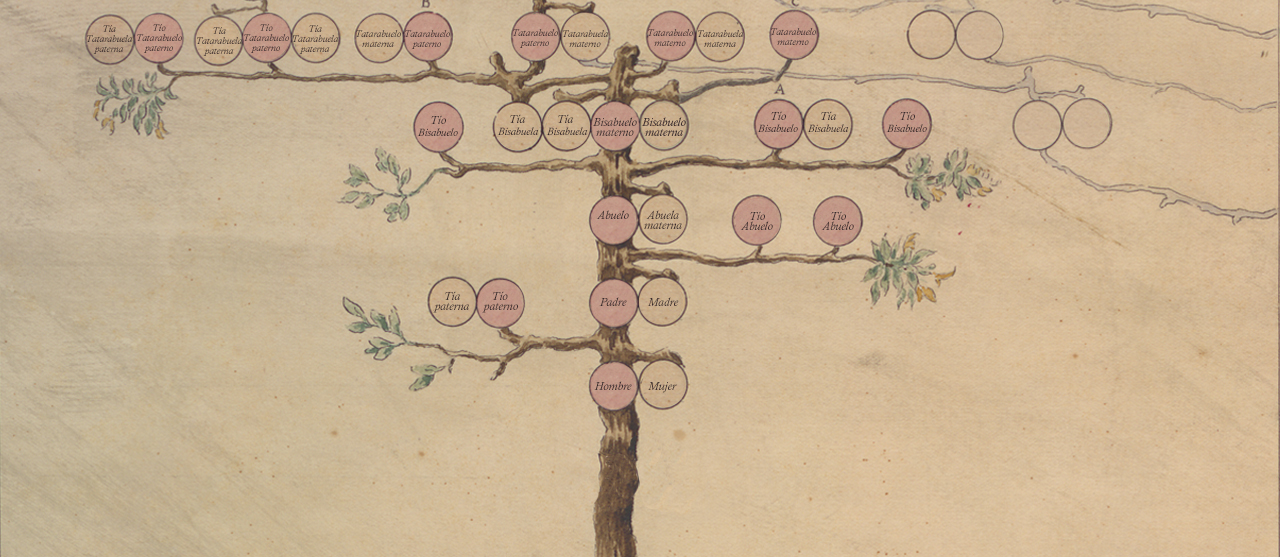The lineage of the wise king
From the triumph of the cursed lineage to the creation of the County of Medinaceli
With a subtitle inspired by a recent book by Fernando Arias, titled The Triumph of an Accursed Lineage, lhe exhibition begins with the ascendant lineage of the wise king as one of the keys to explaining his imperial ambition, his legislative work and the alliances he forged with other European royal houses. It continues with his descendants, starting with a succession crisis that pits his father, King Alfonso X, against his second son, the infante Don Sancho, whom he publicly curses. The enthronement of this cursed lineage which, against the king's will, disinherits the first-born, opens up a long period of instability which - with the parenthesis of the reign of Alfonso XI, who managed to re-establish monarchical authority - will lead, almost a century later, to a new civil war and the assassination of King Don Pedro by his brother Don Enrique de Trastámara. It was in this context of the lack of legitimacy of the monarch - and the breakdown of the balance in the conflictive relationship between nobility and monarchy to the benefit of the former - that the County of Medinaceli was created in favour of the person who represented the first-born line of Alfonso X, disinherited in the previous century.
As an epilogue, the exhibition evokes the construction of two memories, that of the new reigning house of Trastámara which, in the person of Juan I, seeks its legitimacy in the Infantes de La Cerda, and that of the House of Medinaceli, which, from very early on, visually transmits to each generation its status as the first-born line of the ancient kings of Castile and León.
Index
Ancestors and imperial ambition
Stirpe imperiali tam Romana et Constantinopolitana quam Yspana
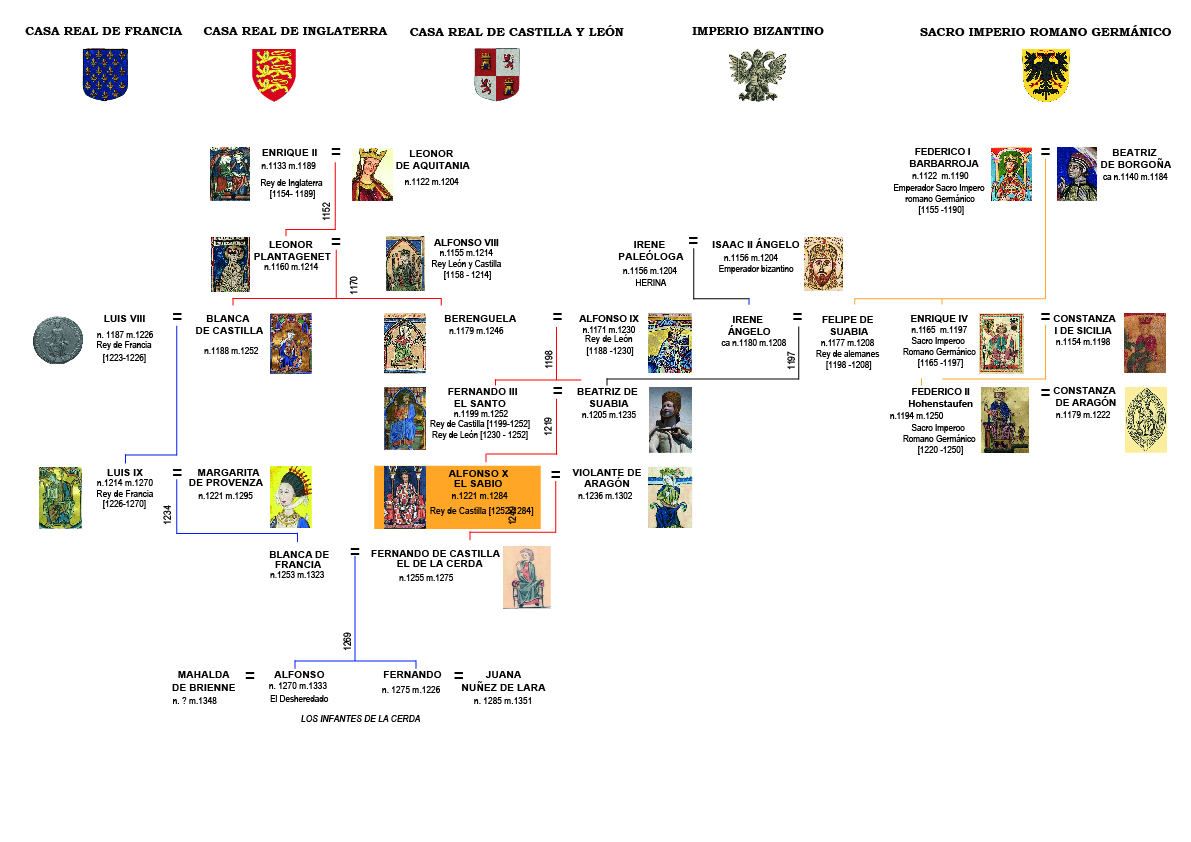
"The first [merced]., qhat made us omneGod wanted him to be our father e by him we shall come to the mundo. The ssegundawhich made us into a noble achievement in mugier from greatt lineage, to whom God granted many mercies in which he wanted that ffuese good in all the goodness that duenna lo deuya sser"
[Alfonso X enumerates the mercies that his father had made to him, Act IV of the Setenario].
The awareness that Alfonso X The fact that he had a high lineage from which he came could be one of the explanatory threads of his reign, since he based his right to be crowned Emperor by the Pope on him and on the choice of the "largest and most qualified" part of the imperial electors, not only for mere ostentation, but also for what such a dignity could contribute to his project of hegemony of the Crown of Castile The same applies to the construction of an ideal of royal authority according to which the kings were vicars of God in their kingdom like the emperor in his empire, an ideal that drew from the imperial theorists in the service of the Hohenstaufen. From the king's assumption of imperial prerogatives would derive the king's exclusive right to legislate, a revolutionary conception, since to the traditional function of the medieval king as applicator and interpreter of the law would be added that of creating it, as he himself expresses it in the Second Game which, for this and other reasons, in addition to being a great legislative work conceived as law for an empire, is an exceptional treatise on political law.
Related content
Alfonso VIII and the creation of a memory dynastic
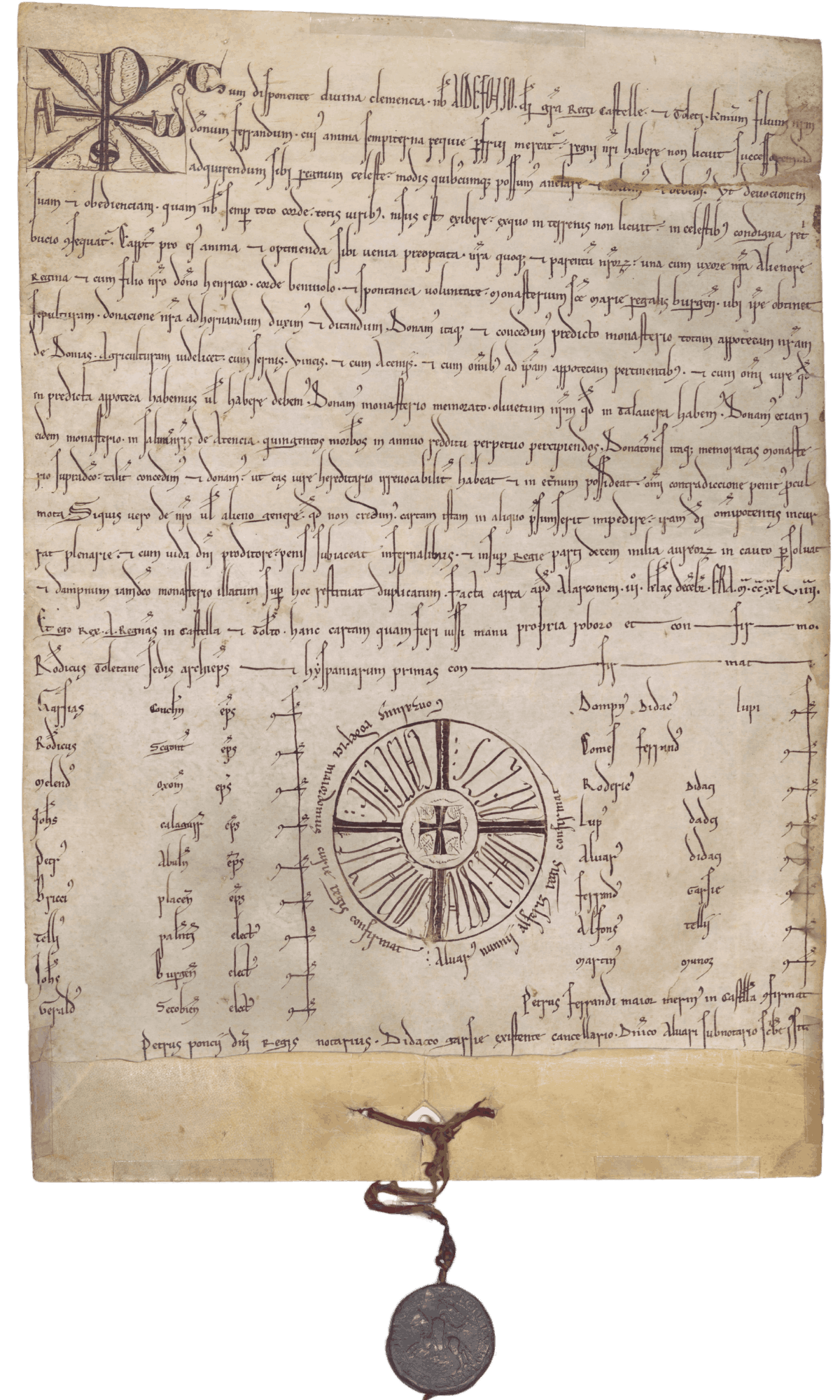
1211, November, 29. Alarcón
Archivo Ducal de Medinaceli, Privilegios Rodados, nº6
Privilegio rodado by which Alfonso VIII donates to the Monastery of Las Huelgas a wine cellar in Dueñas, an olive grove in Talavera and 500 maravedíes of rent on the salt mines of Atienza.
On the day his son and heir, who had just died, would have turned 23, Alfonso VIII y Leonor Plantagenet donated the goods specified in the title to the monastery of Santa María la Real de las Huelgas (Burgos). The construction of this royal pantheon, founded by Alfonso VIII, reveals his interest in creating a dynastic memory whose symbols he introduced in the most solemn type of document issued by his chancellery, the privilegio rodado. The wheel and the pending lead seal, reflections of royal dignity, are innovations of his reign: the cross as symbol of Castile The royal sign is retained, but on the reverse of his seal he uses his speaking emblem, the castle, for the first time.
Related content
Parallels with Emperor Frederick II

1233, June Catania
Ducal Archives of Medinaceli, Messina, No. 150
Privilege of Emperor Frederick II confirming to the monastery of San Salvatore di Messina all the privileges granted to it by his predecessors.
The reign of the emperor Frederick II has many parallels with that of his nephew, Alfonso X, son of his first cousin, Beatrix of Swabia. In order to regain monarchical authority, he promulgated the Liber Augustalis, a legislative compilation that was the precursor of the The Departures. His assertion of imperial power against the papacy provoked a clash that led to his excommunication and finally to his deposition and the pope's promotion of three anti-emperors. During the harsh conflict with the Church he found support in this rich, royal-founded Messinian monastery, the ultimate reason for this privilege.
Related content
Alfonso X takes care of the memory of his lineage
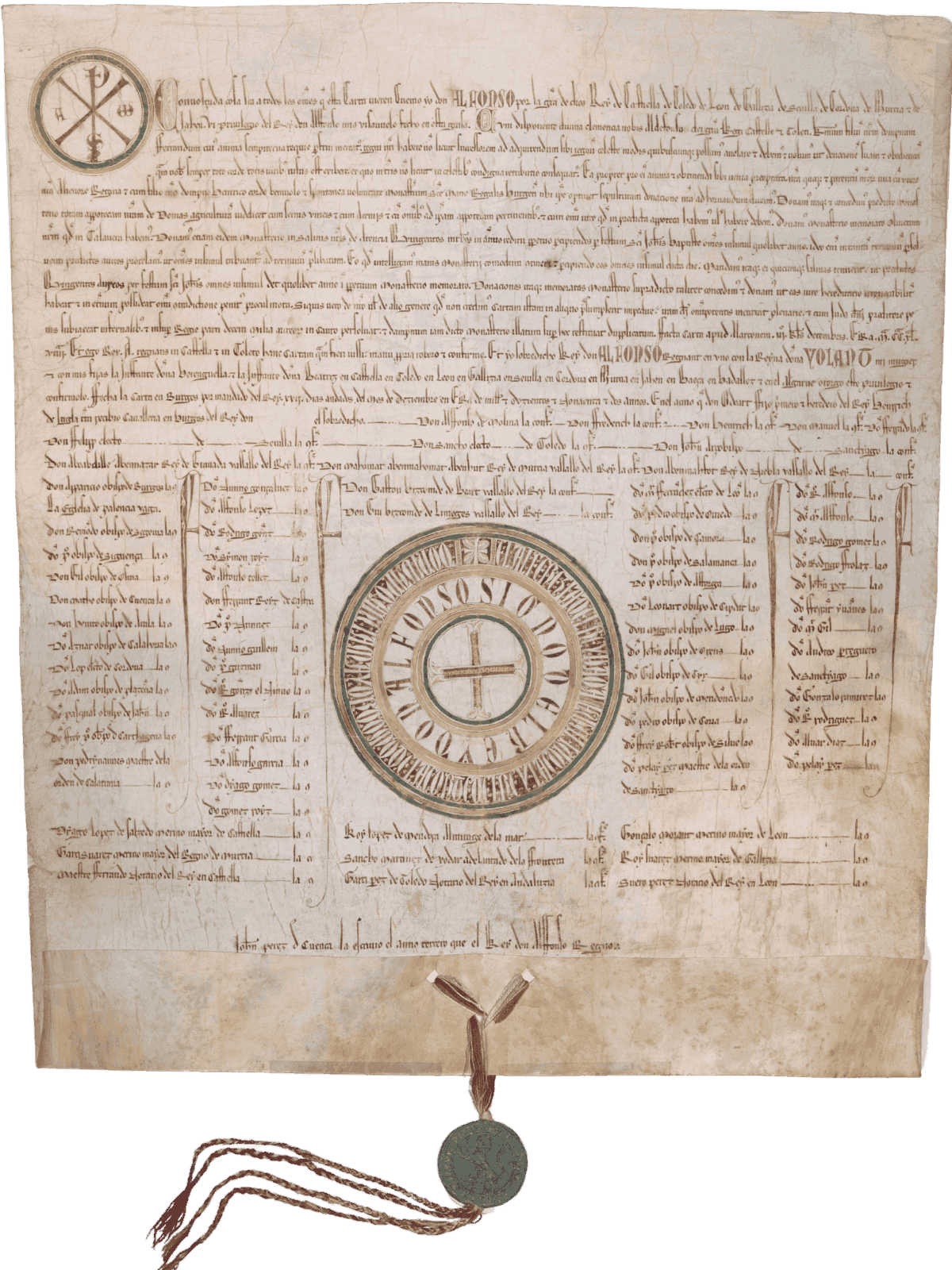
1254, December, 17. Burgos
Archivo Ducal de Medinaceli, Privilegios Rodados, nº7
Privilege of confirmation by Alfonso X of the donation made by his great-grandfather Alfonso VIII of the winery of Dueña and the olive grove of Talavera to the Monastery of Santa María de las Huelgas in Burgos.
Alfonso X continued to favour this Cistercian monastery, exceptional in many ways for being of royal foundation, being directly subject to the authority of the pope and serving as the mother house of all the female Cistercian abbeys in Castile and León. In its high altar, his father armed himself as a knight, Ferdinand III, His grandmother, Doña Berenguela, retired there to die and be buried, as did his mother, Beatrix of Swabia. His sister Berenguela, one of the few members of the family who never left him, assumed the temporal powers of the abbey, taking the title of "Abbot".sennora e mayor del monesterio"to protect the prestige and memory of his lineage.
Related content
Fernando de la Cerda, crown prince
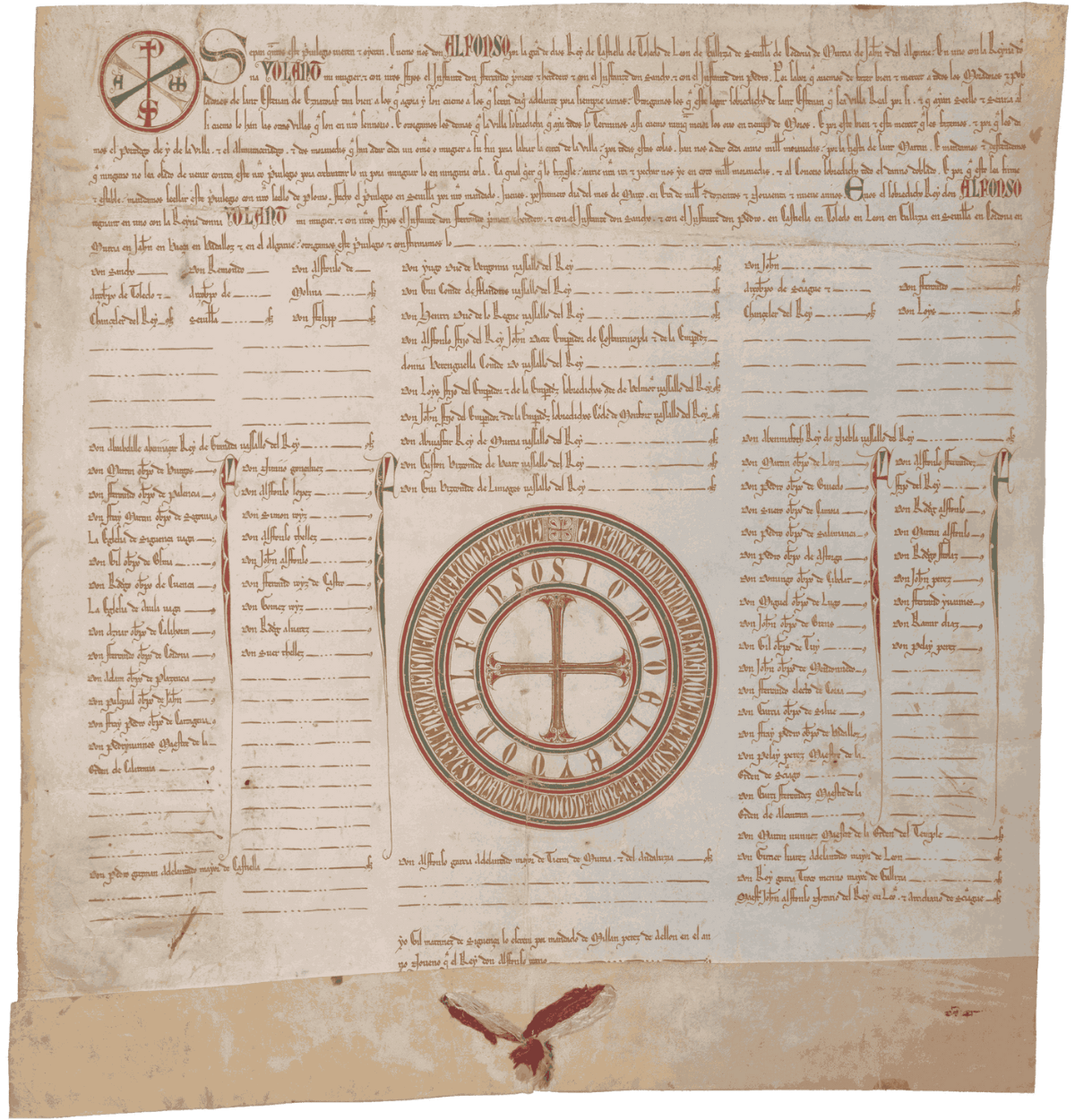
1261, March 31. Seville
Archivo Ducal de Medinaceli, Privilegios Rodados, nº9
Alfonso X declared Santisteban del Puerto a royal town and granted certain liberties and freedoms to its inhabitants.
Although this document should be placed in the context of the repopulation policy, we would like to point out that it already contains the following information Fernando de la Cerda as heir and steward of the king and that, in the space reserved for the king's immediate vassals, many of the European magnates who, personally or by proxy, had paid homage to the king, are listed as confirmers. Alfonso X in exchange for exorbitant amounts of silver. This policy of creating a virtual imperial court with the vassalage of great princes such as the Duke of Burgundy or the Count of Flanders, As well as conditioning international relations, it irritated the nobility and the councils because of its cost.
Related content
Alliance between the royal houses of Castile and France
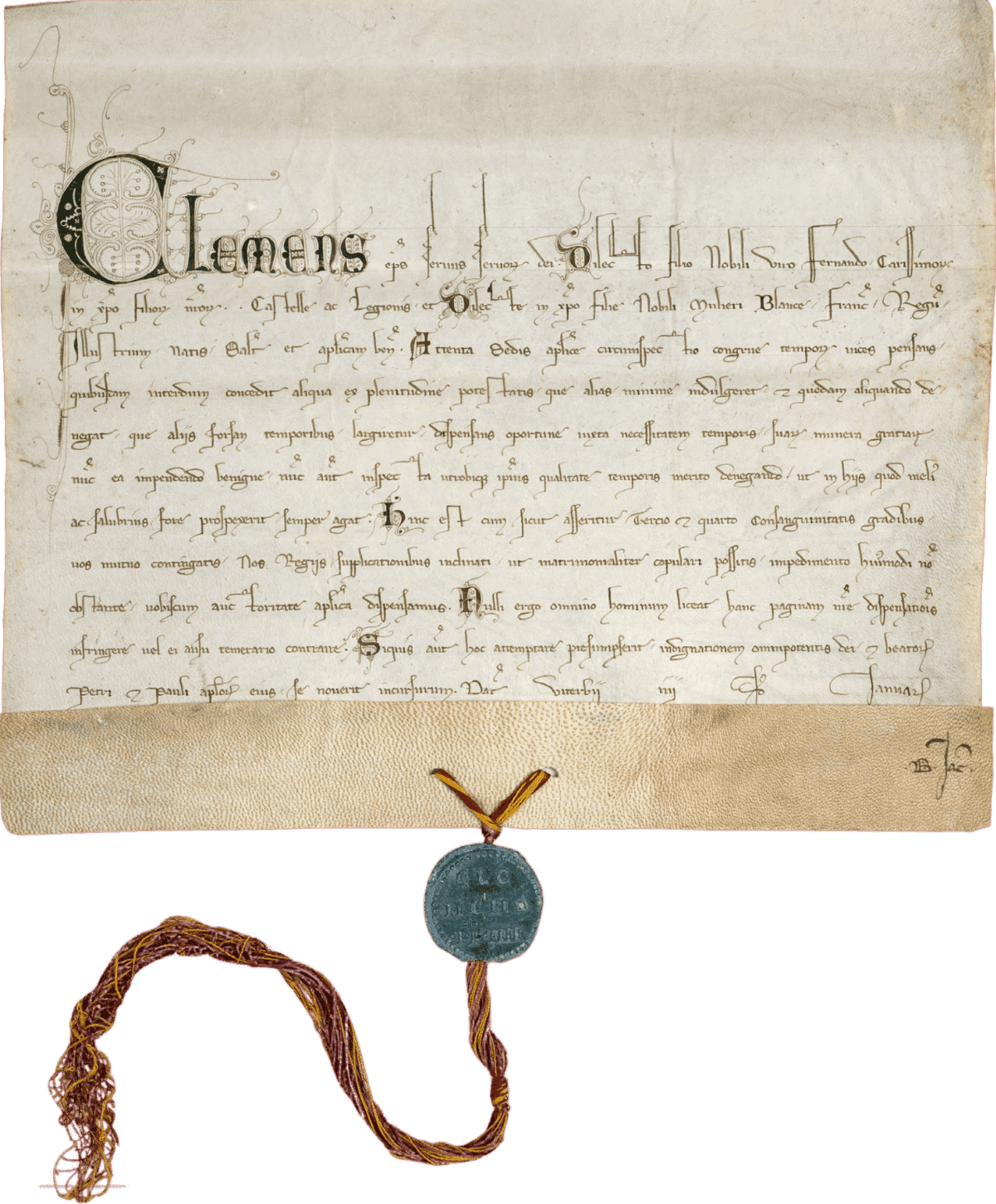
1267, January, 10. Viterbo
Archives Nationales (France) J 435 No 5
Bull of Clement IV granting the mandatory dispensation of consanguinity.
The grandmother of Alfonso X and the mother of Louis IX, better known as Saint Louis, were sisters, so the King of France, although only seven years older than the King of Castile and León, was his uncle. Both queens, Doña Berenguela y Doña Blanca influenced his grandson and son respectively, especially in the second case as the premature death of Louis VIII of France left the education of the future Saint Louis in the hands of his mother and regent, Blanca de Castilla. The close relationship between the two royal houses partially explains the choice of a daughter of the King of France as the wife of the son and heir to the kingdom of Castile and León, Fernando de la Cerda.
The alliance between the France and Castile had been attempted earlier with the betrothal of Alfonso X's eldest daughter, Berenguela, with the first-born son of Louis IX, which provided for the union of the two crowns, an engagement that was broken by the death of Prince Louis in 1260.
The importance that Louis IX and the pontiff granted to this marriage is reflected in the haste with which the latter granted the preceptive canonical dispensation from consanguinity and even the authorisation to celebrate the marriage before the legal age of fourteen.
Related content
Marriage of Ferdinand de la Cerda and Blanche of France
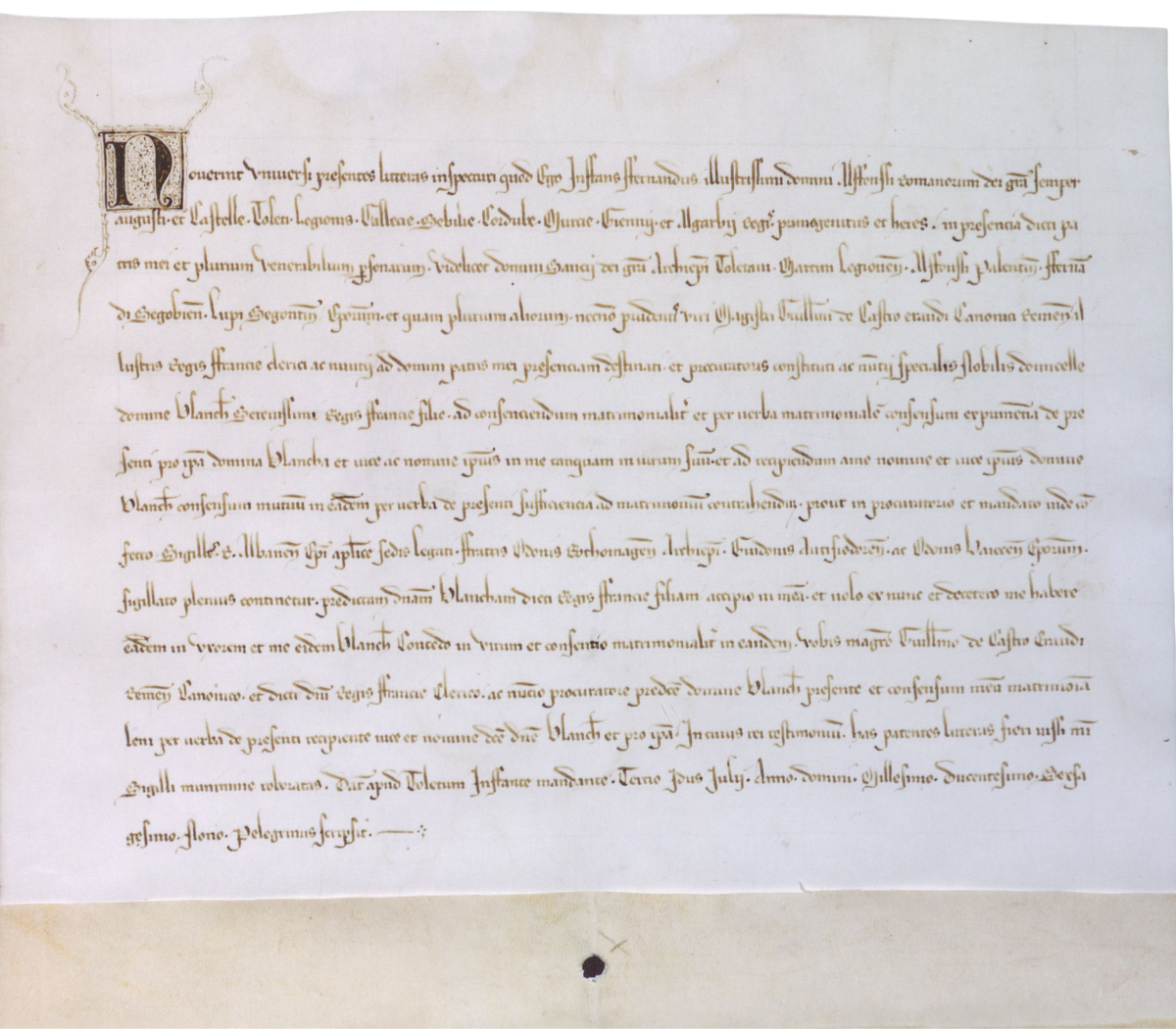
1269, July 13. Toledo
Archives Nationales (France) J 599 no 8 / Facsimile of Doce Calles Editions
The Infante Don Fernando marries Blanca de Francia, daughter of King Saint Louis, by a present word.
The candidacy for empire of the brother of the King of England, Richard of Cornwall, increased interest in an alliance with France, which had been desired from the beginning of the reign. In 1266, at the castle of Saint Germain-en-Laye, procurators of the infante don Fernando de la Cerda signed the marriage contract with Blanche de France, daughter of Louis IX. Shortly before he came of age, on 13 July 1269, in a solemn ceremony in the presence of the kings and great figures of the Court, the prince Don Fernando took Doña Blanca as his wife, represented by the canon of Reims, Guillaume de Châtellerault, a ceremony of which his chancellery issued this solemn act.
Related content
Nuptial blessing of marriage
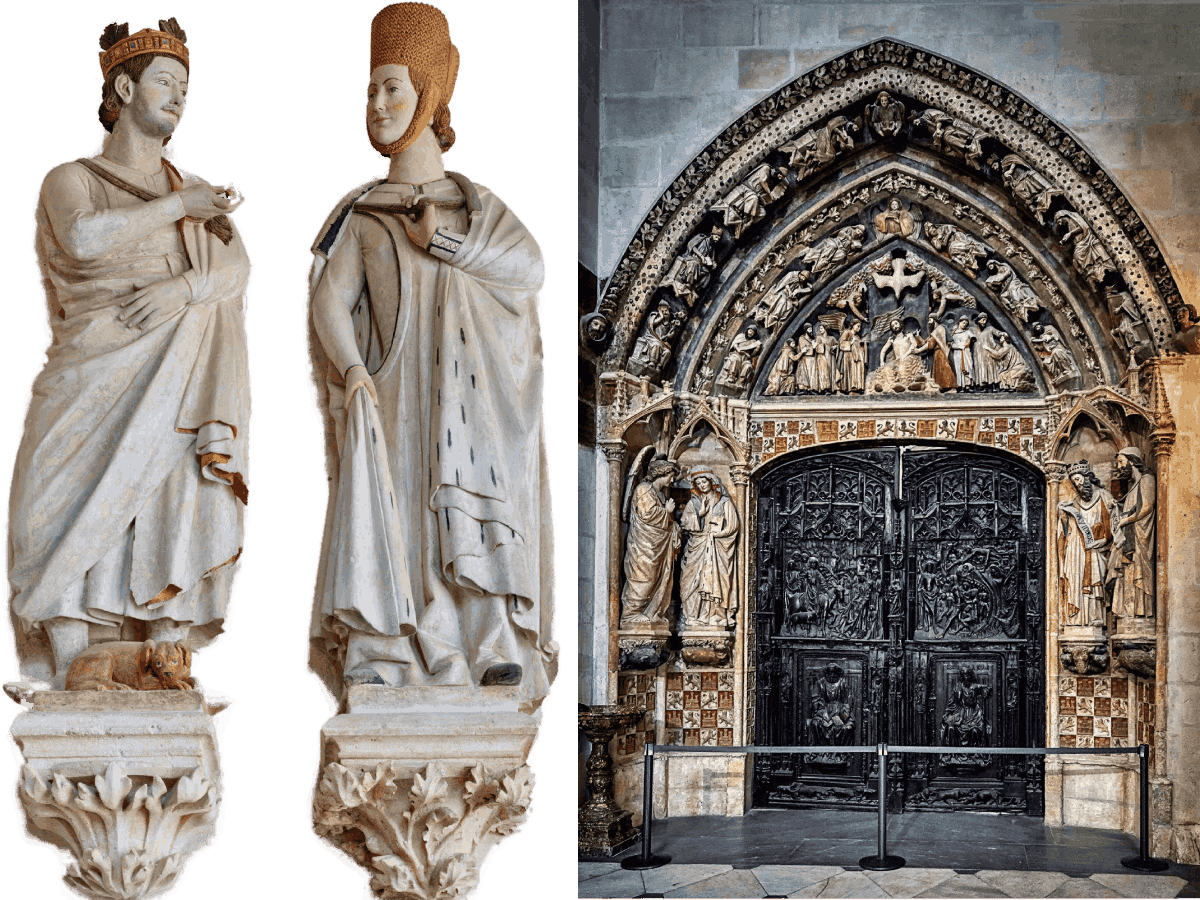
Sculptures of Ferdinand III and Beatrix of Swabia
Black door of the cathedral of Burgos
Nuptial blessing of the marriage of Fernando de la Cerda and Blanca de Francia.
The wedding blessing of the marriage was celebrated in the cathedral of Burgos on 30 November 1269, a date that was not chosen at random, as it was the fiftieth anniversary of the wedding in the same cathedral of Burgos. Ferdinand III and Beatrix of Swabia. Not in the same building, as a brand new Gothic temple had been built over the old one, to which Alfonso X added a new cloister completed in the autumn of 1269, whose main sculptures would represent those first bride and groom presented to the new ones as a model of the royal Christian marriage. To connect it with the Church, he ordered the carving of what is known today as the Black Gate in which, against a heraldic backdrop of bas-reliefs of castles and polychrome lions, he develops an iconographic programme in which biblical royalty is linked to the mysteries of the incarnation and baptism.
Related content
The crown prince's apprenticeship
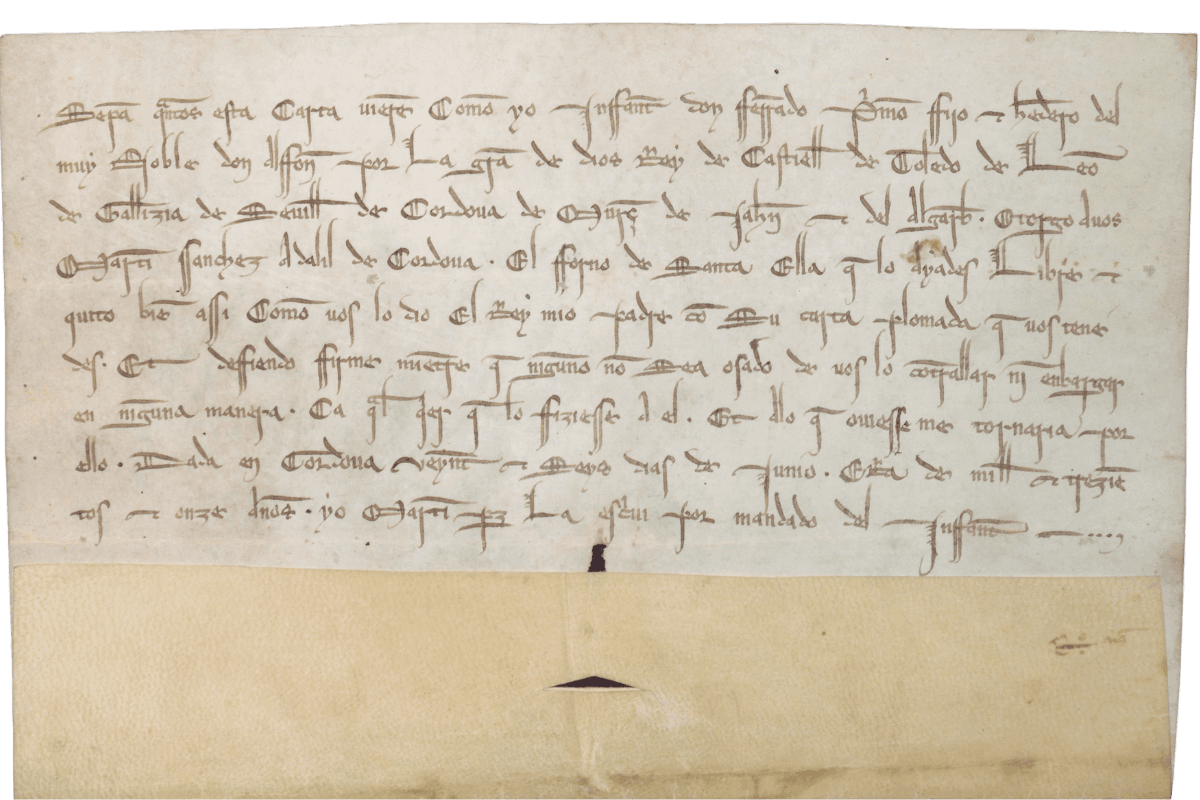
1273, June, 26. Cordoba
Ducal Archives of Medinaceli, Priego 73-1
The Infante Don Fernando confirms the grant he had made to his father to Martín Sánchez, leader of Córdoba, of the oven of Santaella.
The infant heir, in order for him to learn the correct exercise of power, was entrusted with a a number of upstream functions to his accession to the throne. After his marriage, as his father had done with him, Alfonso X he confided to his son, Fernando de la Cerda, the government of the kingdom of León and from 1272 of Murcia. In the spring of 1273 he was sent to Cordoba to keep a close watch on the frontier of the kingdom of Granada, where the high nobility who had revolted against his father had "denatured". Shortly afterwards, he was commissioned to head a commission to negotiate with the rebels, which achieved a certain degree of pacification. It is in this context that this privilege was granted by the prince's chancellery to a Cordovan leader.
Related content
Death of the prince and failure of the empire
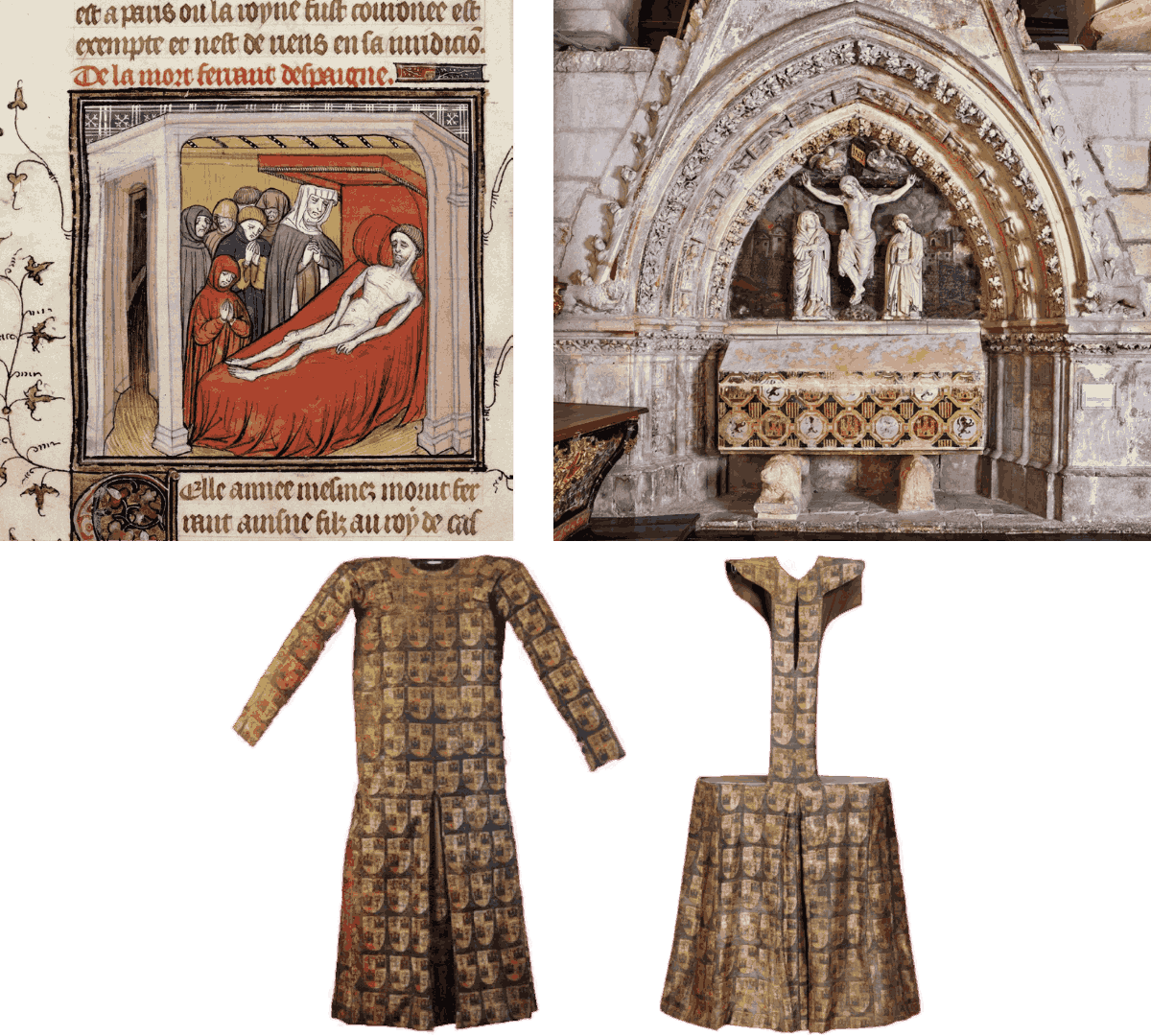
British Library Miniature: Death of Don Fernando de la Cerda
Sepulchre of Don Fernando de la Cerda in the Monastery of Las Huelgas (Burgos)
Saya and Pellote of Don Fernando de la Cerda
Death of the Crown Prince
The pacification of the kingdom made it possible to prepare for the long-awaited journey to Beaucaire to personally persuade Gregory X of his superior right to the imperial crown. The large entourage and the long absence made it necessary to convene a court in Burgos with the dual purpose of voting a service to defray expenses and appointing the prince as regent. Fernando de la Cerda. A year later, the dream turned into a nightmare, as the pope's outright refusal to invest him as emperor was compounded by the news of the death of his son in Villa Real, on 20 July 1275, where he had gone a few days earlier to lead the troops that were to stop the invasion of the Benimerines.
The infant was buried in the monastery of Las Huelgas with his own costume adorned with repetitive quarters of castles and lions, both emblems of the lineage and ideograms of the kingdoms, symbolic fusion of lineage and ruled land, This motif, however, is not repeated in the polychrome of the tombs, which, by adding his mother's bars of Aragon, disassociates the infant from the governed land, leading us to believe that the stone of the tomb was painted or repainted at a later date.
Related content
The succession crisis
Succession according to the line items

ca. 1265
National Library of Spain VITR/4/6 - Facsimile of Ediciones Doce Calles
Law II, Title XV, Part II
Today, it is almost unanimously agreed that the Items had been in full force and effect since at least 1265. For this reason, the death of the infant Fernando de la Cerda raised the problem of the existence of two rights, one the traditional Castilian one, according to which the crown corresponded to the eldest of the king's surviving sons, and the other, the one established in the Law indicated by the manícula, II, of Title XV of Partida II: "...] if the eldest son or daughter dies before he or she inherits, if he or she leaves a son or daughter who has a legitimate wife, he or she shall inherit, and no one else shall inherit.". If the first one was applied, the succession corresponded to the infant. Don Sancho, if the second was used, to his brother's first-born son, Alfonso de la Cerda, a child of just a few years old.
Related content
Peace negotiations with France
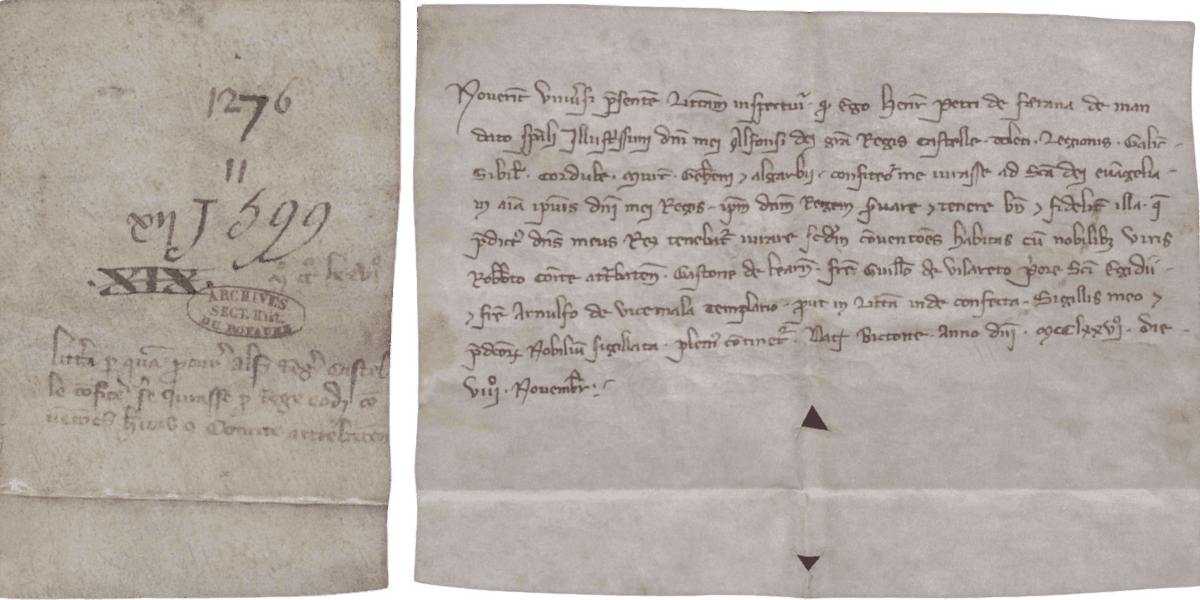
1276, November, 8. Vitoria
Archives Nationales (France) J 599 nº11 - Facsimile of Twelve Streets Editions
Enrique Pérez de Arana, the king's chief repostero, swore in the name of Alfonso X that he would fulfil the conditions of peace agreed with the plenipotentiaries of Philip III.
Philip III the bold, Blanca's brother, deployed a two-pronged strategy to claim his nephews' right to the crown: to call up an army to threaten Castile and send ambassadors to the wise king. In this document, the king's chief repostero swore in his name that he would fulfil the pacts that he and the bishop of Burgos had negotiated in Vitoria with the plenipotentiaries of the king of France. By them, Alfonso X among other things, it undertook to try to get the nobility to revoke the oath and homage paid to Don Sancho and to convene courts to settle the succession question, to which the King of France could send his delegates. None of these pacts prospered, but they do reveal that Alfonso X at the end of 1276 did not consider the succession to be res judicata.
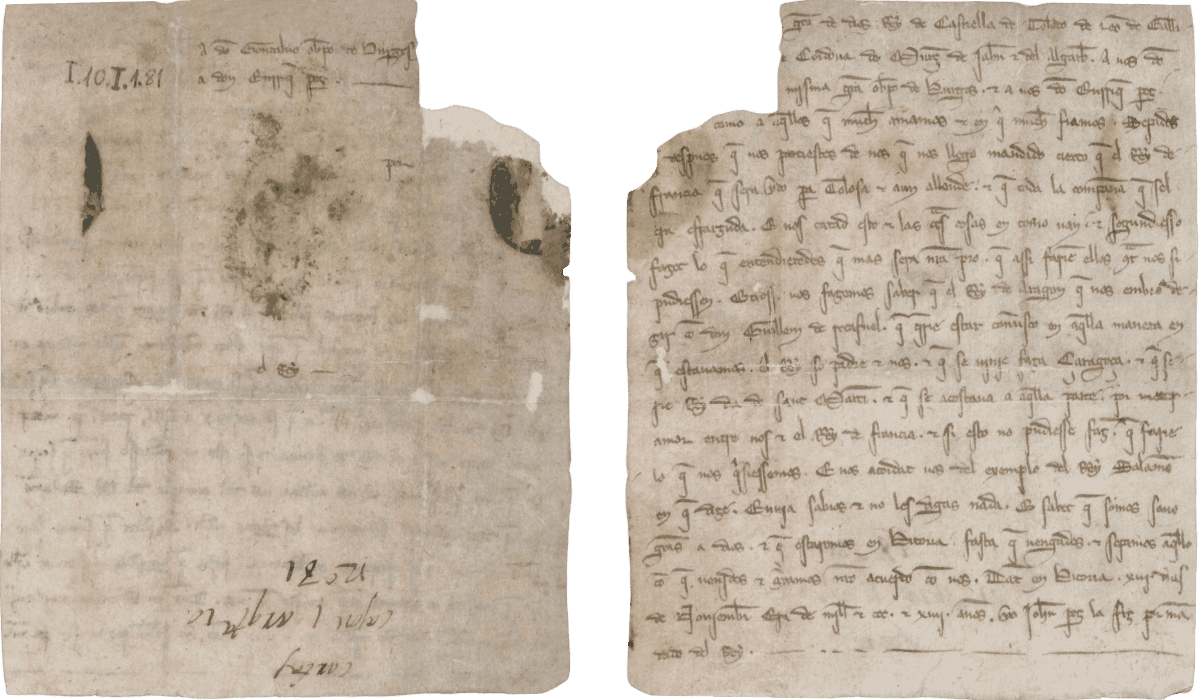
1276, November, 13. Vitoria
Archive of the Cathedral of Toledo, I.10.I.1.81. - Facsimile of Doce Calles Editions
Secret letter from Alfonso X notifying his plenipotentiaries in Vitoria of the withdrawal of Philip III's army to Toulouse.
The aforementioned pacts had been reached under the threat that the large army which, under the command of Robert of Artois and Gaston de Bearne, had put an end to the civil war in Navarre, also fulfilled its second objective, invade Castile. However, the logistical problems caused by its excessive size meant that it was necessary to Philip III The news reached Alfonso X when the negotiators were on their way to meet the King of France to ratify the pacts. The wise king wrote to them to tell them the news and to warn them that, the threat of war has disappeared, it was unnecessary to stick to what had been agreed, leaving them to do "...".what you understand will be more to our advantage than what they would do against us, if they could".
Related content
Pope calls for peace
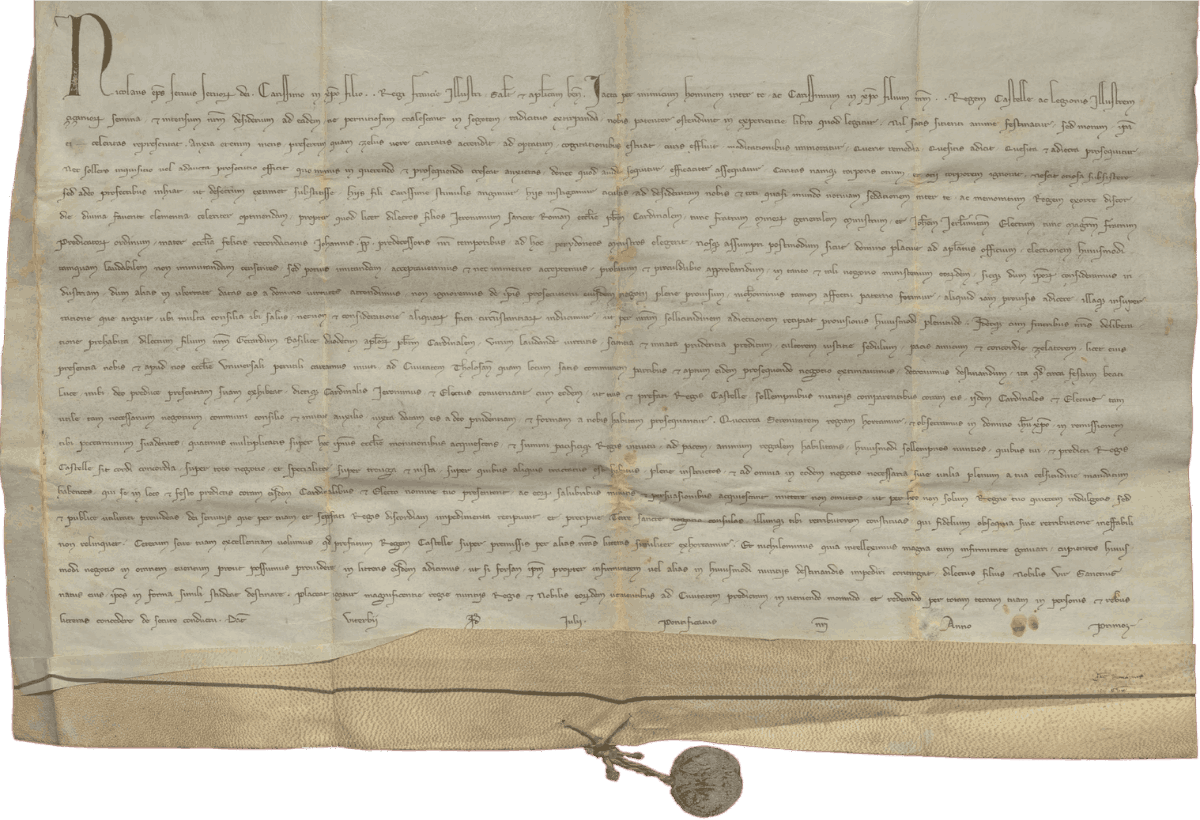
1278, July, 15. Viterbo
Archives Nationales (France) J 600 No 15
Papal diplomacy seeks peace: Nicolas III urges the King of France to make peace with Alfonso X.
The duality of inheritance rights and the complicated political situation that has arisen made the king hesitate. Most of the nobility and the councils supported the cause of the prince. Don Sancho, but Philip III of France, uncle of the infantes de la Cerda, and a shifting group of nobles led by Juan Núñez de Lara, that of his grandson Alfonso. The latent state of war between France and Castile It lasted at least until 1282, and if it did not break out openly, it was because the intense English and papal diplomatic activity forced the kings to reach successive truces. In this bull, the Pope Nicolas III, continuing the work of his predecessor John XXI, he urged Philip III to sign the peace and summoned him to an interview in Toulouse with the King Alfonso X and the intermediation of a cardinal.
Related content
Prison of the infantes de la Cerda
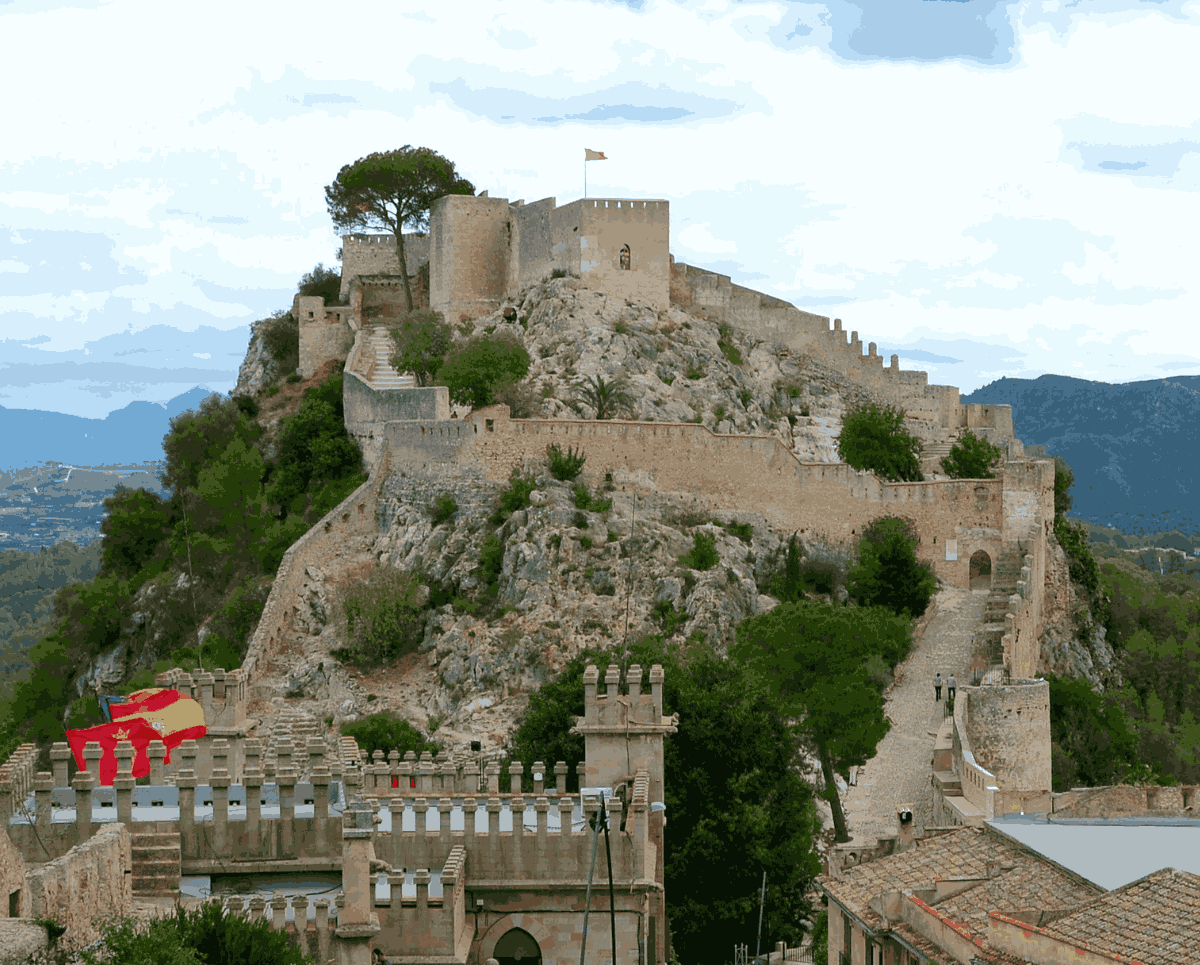
Photograph of Játiva Castle
Castle of Játiva, state prison of the kings of Aragon, inaugurated by the infantes de la Cerda
The Infantes de la Cerda imprisoned in Játiva
Persuaded by her brother, the King Peter III of Aragon, offered him refuge in his kingdom, at the beginning of 1278 the Queen Violante, accompanied by her grandchildren, fled to Aragon. It is difficult to interpret this action by the queen, as, in addition to provoking a unbridgeable rupture with her husband, the objective and foreseeable result is that she left in the hands of the King of Aragon the succession rights of her grandchildren, an extremely valuable card in the political relations of the latter with the kingdoms of France and Castile. At the end of July 1279, he was proclaimed heir to the throne. his son Sancho at the courts of Segovia in 1278, Doña Violante, with the guarantee that she would be restored to the honour and property she enjoyed before she fled, returned to Castile leaving their grandchildren in Aragon imprisoned in the Játiva Castle.
Related content
Proclamation of Sancho as heir apparent
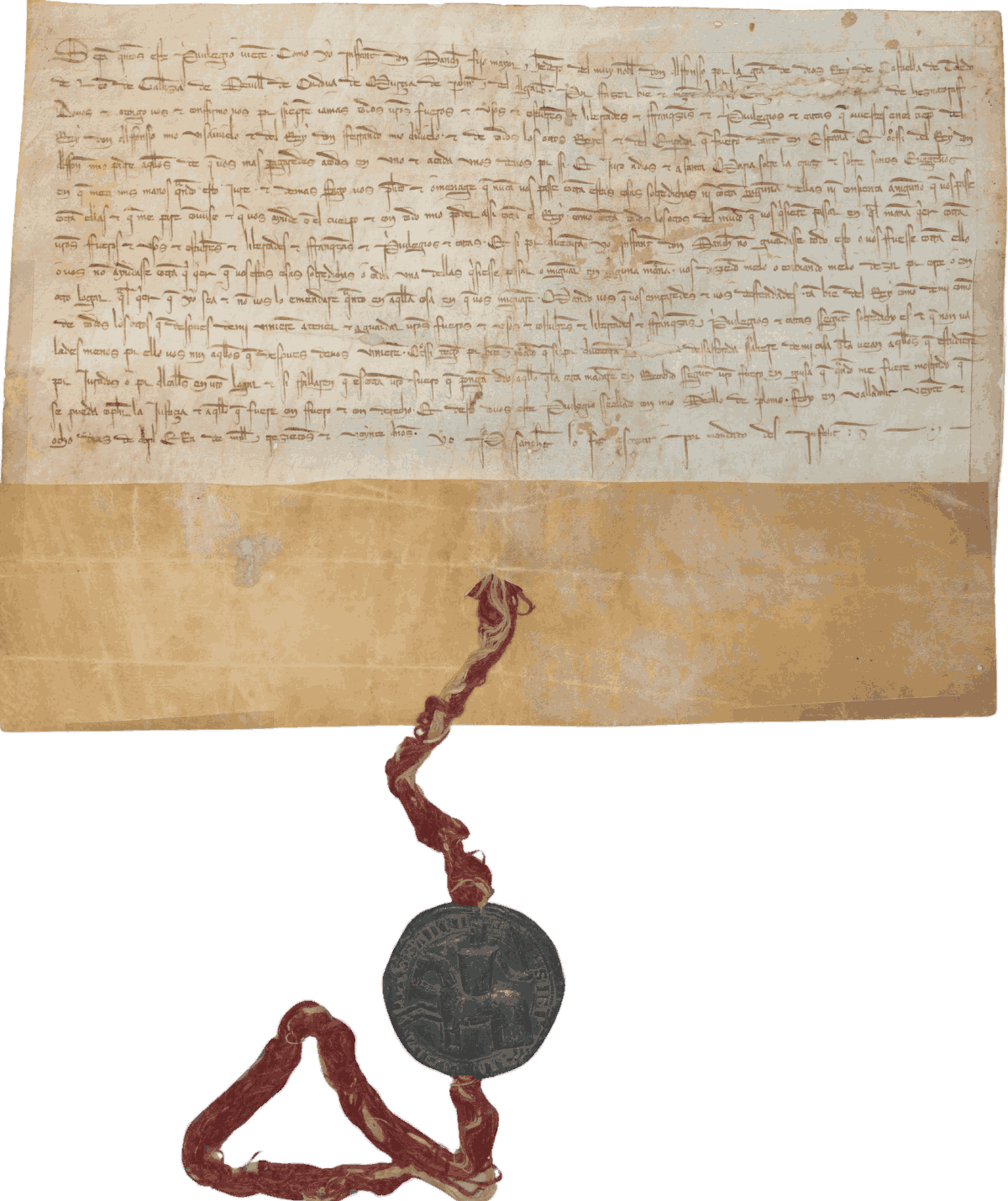
1282, April, 28.
Ducal Archives of Medinaceli, Santisteban 1-21
Privilege letter from the Infante Don Sancho confirming the privileges and franchises granted to the town of Santisteban by Alfonso X. Lead seal of Sancho IV
Proclaimed heir, Don Sancho, began to act behind his father's back, from whom he gradually distanced himself until the definitive break in the Valladolid Assembly of 20 April 1282, which deposed the king and transferred all his powers to the prince. His chancellorship immediately began to issue privileges to win followers to the cause, as in this diploma, written a few days after the deposition, in which, as the Assembly had prescribed, Sancho avoids claiming the title of king, but he uses all the symbols of royal dignity and brings his father's reign to a close by confirming the town of Santisteban del Puerto the [...]customs, customs, freedoms, and privileges and immunities e cartas que obistes en el tiempo del Rey don Alfonso".
Related content
Rebellion of the Infante Don Sancho and assistance from Abū Yūsuf
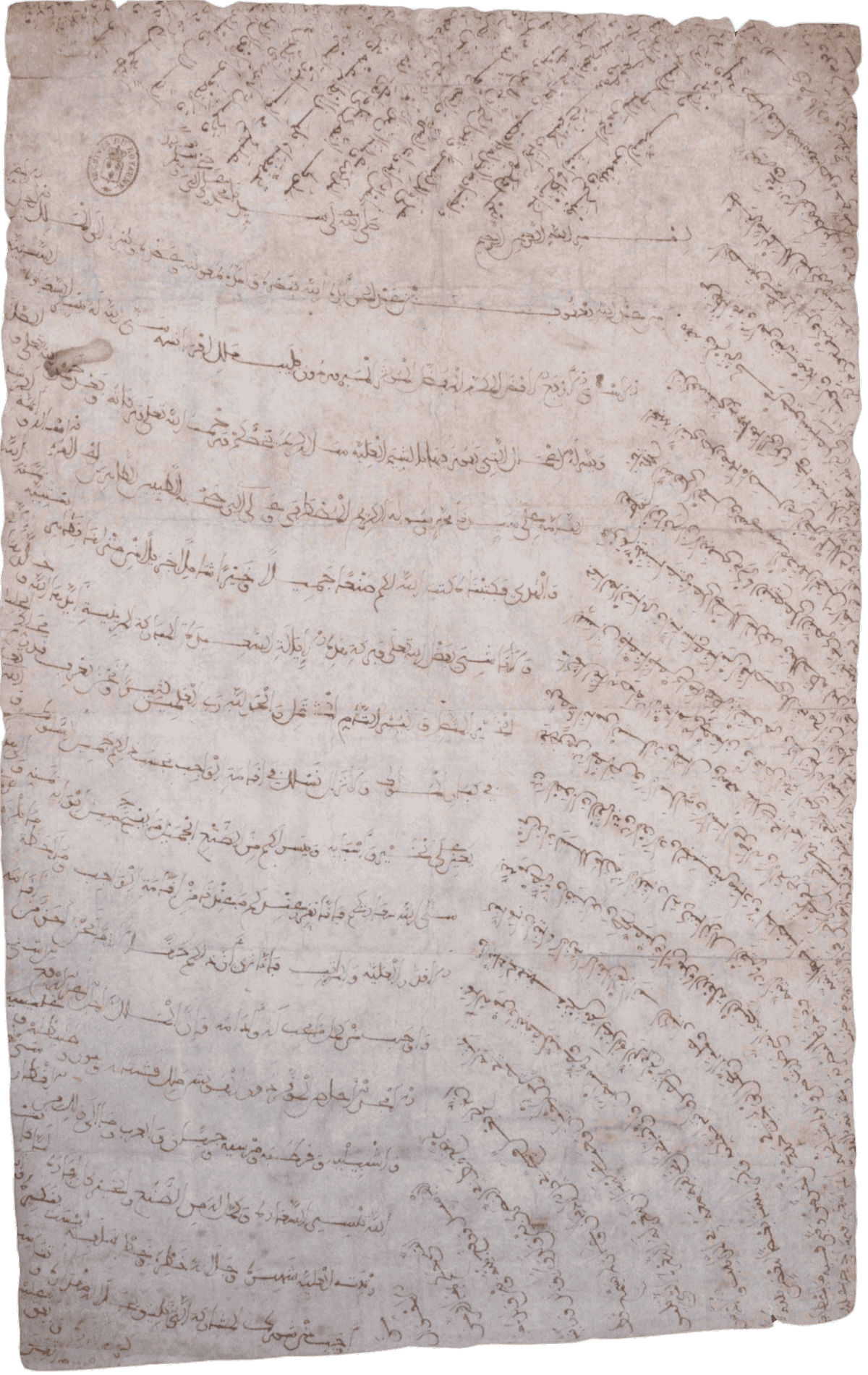
1282, October, 24.
Archives Nationales (France) AE/III/200 - Facsimile of Twelve Streets Editions
Letter from the Emir of the Benimerines, Abū Yūsuf, requesting the King of France, Philip III, to help Alfonso X in the war against his son Sancho.
Alfonso Deprived of the obedience of the kingdom, nobles, clergy and councils and abandoned by almost his entire family, asked for help to all the neighbouring kings. None of the Christians to whom he was closely related offered it. Relief came from whom one would least expect, its main enemy, the one who had invaded the Iberian Peninsula in 1275, the Sultan of the Benimerins, Abū Yūsuf who, in this letter, invites the King of France to join the coalition against the infante don Sancho. Thanks to the gold and the troops it sent to the peninsula, the situation of the civil war was reversed to the extent that some of his sons returned to their father's obedience and all the chronicles narrate Sancho's attempt, hindered by his supporters, to come to terms with his father.
Related content
Disinheritance and curse of the Infante Don Sancho
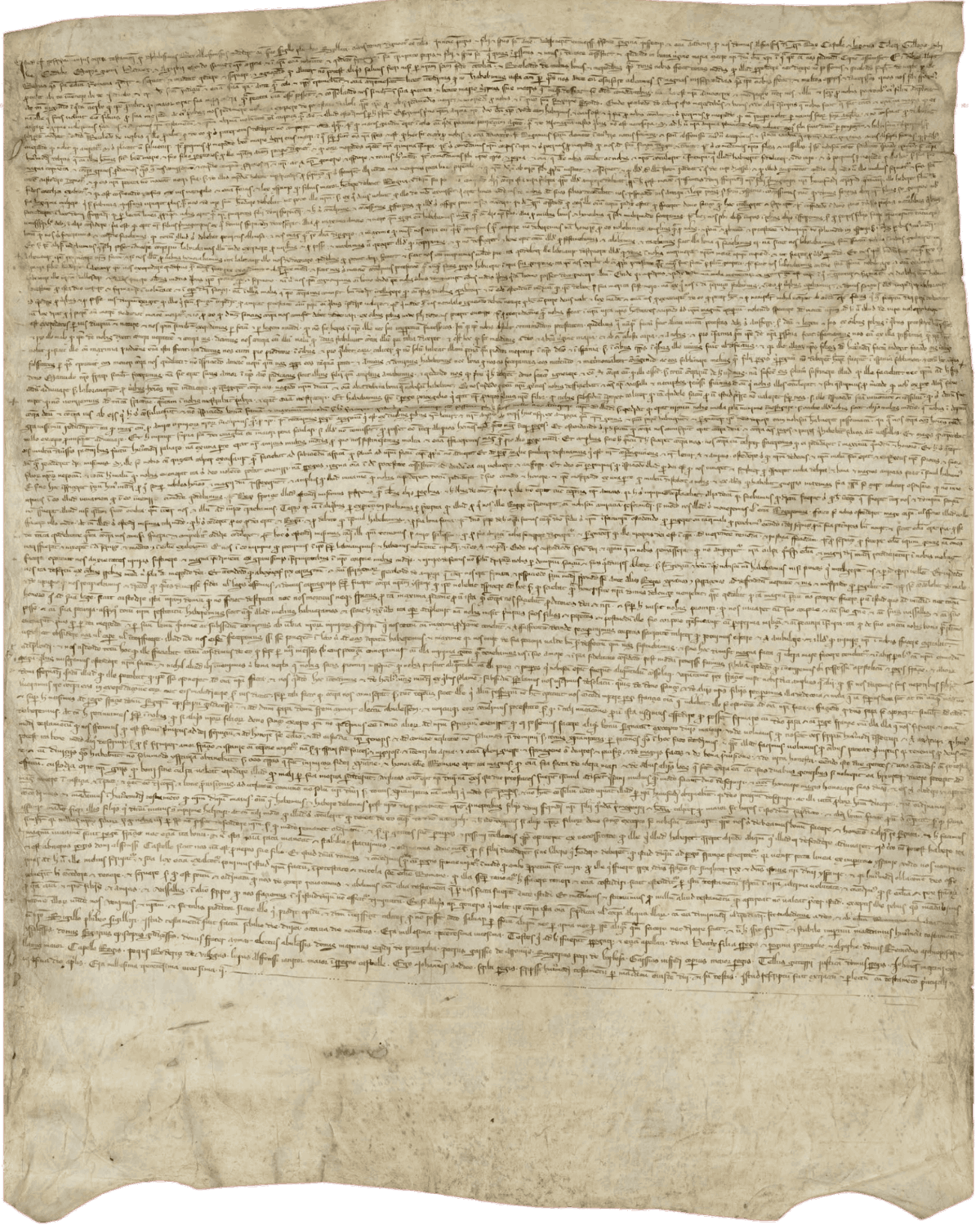
1282, November, 8. Seville
Latin version of the testament of Alfonso X - Archives Nationales (France) J 601 nº 31
Disinheritance and curse of the Infante Don Sancho
E por ende ordenamos [...] que el nuestro señorío mayor de todo lo que avemos y aver devemos finque después de nuestros días en nuestros nietos, fijos de don Fernando nuestro fijo, que fue primero heredero, de guisa que el mayor heredede este nuestro señorío....
For whose huge crimes and many others that he irreverently committed against us, without fear of God nor respect his father, which would be too long to relate or record in writing, we curse him as deserving of the paternal curse, reprobate of God and worthy to be justly abhorred by men and we subject him henceforth to the divine and human curse and as a rebellious, disobedient and contumacious son, ungrateful and even ungrateful, and degenerate, we disinherit him and deprive him of any right he ever had in our kingdoms, [...] so that neither he nor any of his descendants can ever happen to us in anything.
Public judgment delivered by Alfonso X in the Alcázar of Seville on 9 November 1282.
Related content
The process of consolidation of the cursed dynasty
Alteration of the text of the Departments
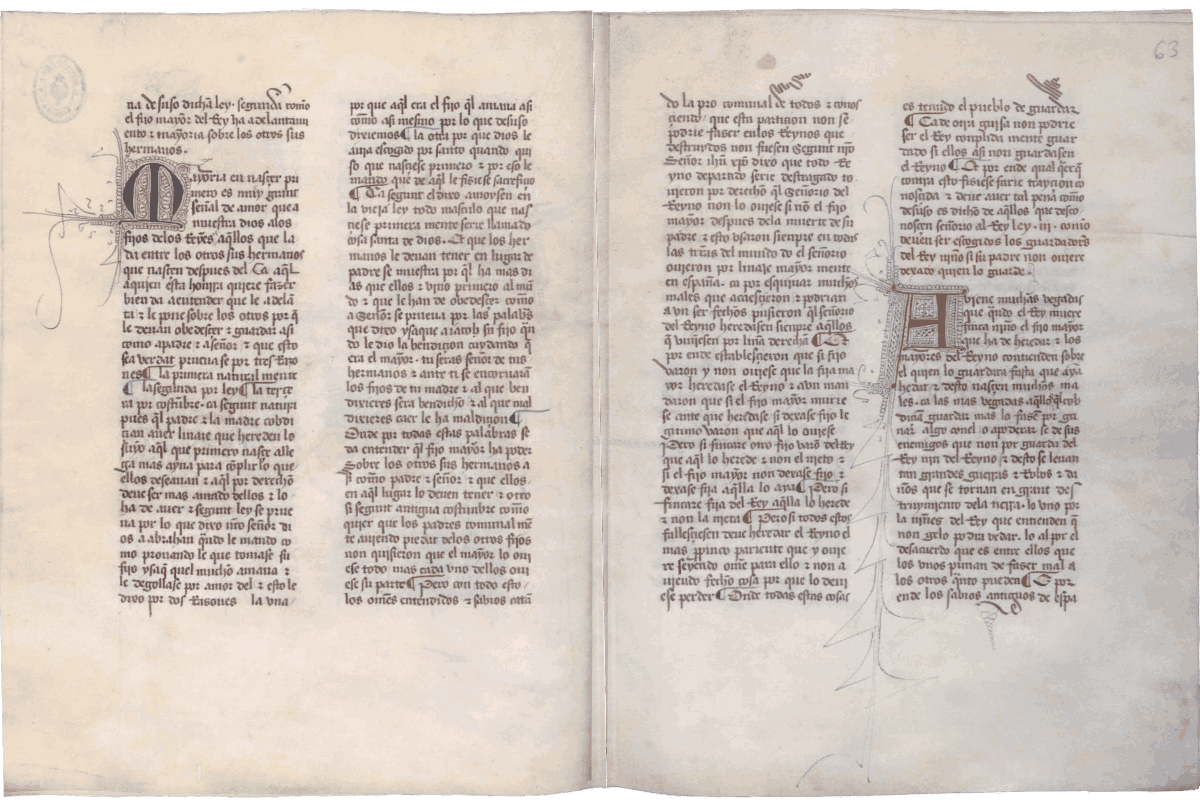
ca. 1290
Biblioteca Nacional de España Mss/6725 - Facsimile of Ediciones Doce Calles
Law II, Title XV, Part II
A la death of Alfonso X, on 4 April 1284, the documentation of his chancellery was plundered. disappearing the will and the codicil and any other document who questioned the legitimacy of the new king, Sancho IV who, despite the testamentary dispositions of the wise king, had been recognised as such by all the estates of the kingdom. It is at this time that specialists in the legislative work of Alfonso X place the interpolation, highlighted in bold type, in the text of Law II of Title XV of Part II of Part II that legitimises his coronation: "They also ordered that, if the eldest son should die before he inherits, if he leaves a legitimate male son, that he should inherit, but if another fixed male of the King's, I will inherit him and not the grandson.".
Related content
Sancho IV signs peace with France
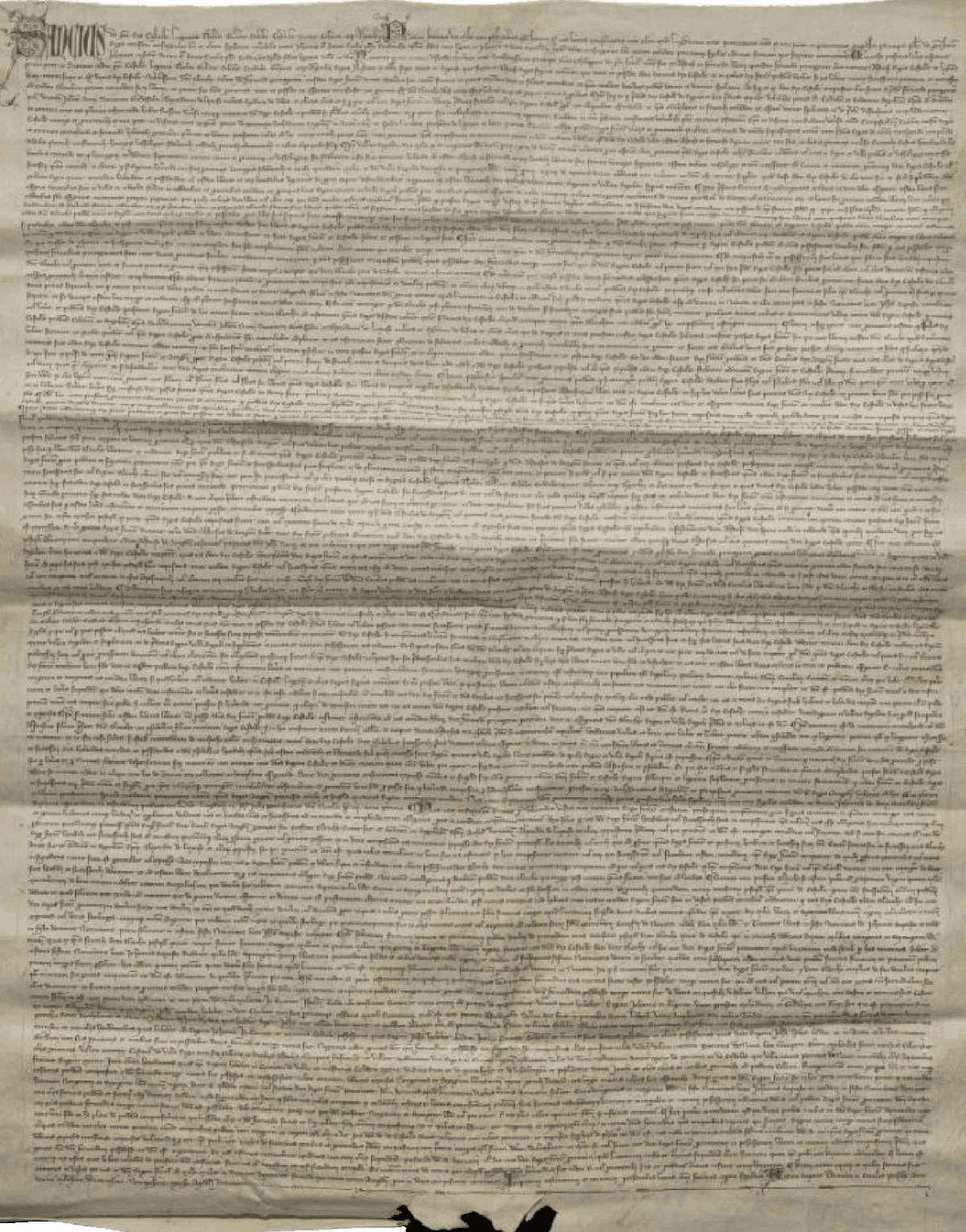
1290, April, 9. Bayonne
Ratification by Sancho IV of the Treaty of Lyon of 1288 - Archives Nationales (France) J/ 601 no. 23
Sancho IV signs peace with France
Since shortly before the death of Alfonso X, France was more interested in defending the Papal donation of Aragon to Charles of Valois, son of Philip III, than in claiming the rights of the Infantes de la Cerda. Sancho IV He seized the opportunity of this situation by sending ambassadors to France to negotiate peace with the new king of France, Philip IV the Beautiful. The result was the signing of the Lyon peace treaty of 1288, ratified in Bayonne in 1290, whose clauses concerning the Infantes de la Cerda would soon become a dead letter, but which made it very clear that the King of France was prepared to disengage himself from the defence of the rights of the infantes de la Cerda.
Related content
Blanche de France tries to get her children back
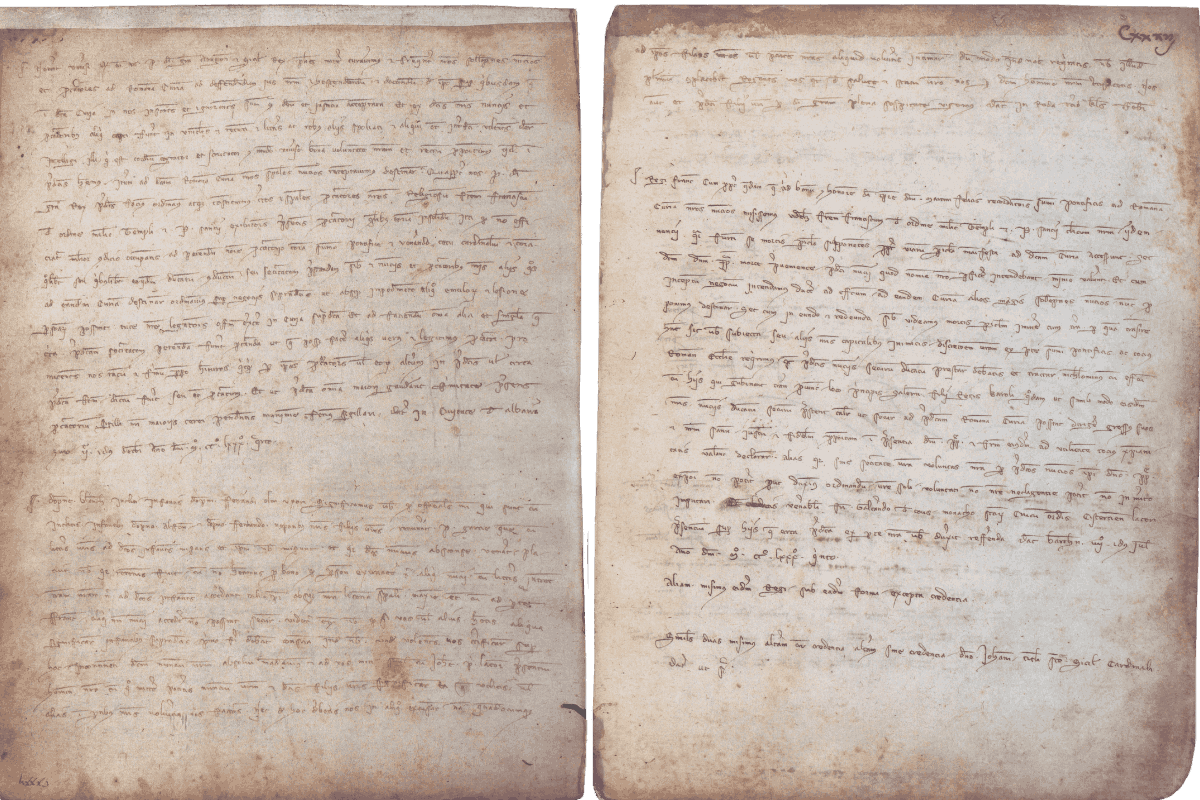
1285, January, 30. Roda
Archivo de la Corona de Aragón, chancellery reg. N 47 fol. 132 and 33 LVI - Facsimile of Ediciones Doce Calles
Minute of the Letter of Peter III to Blanche of France in the register of his chancellery.
Blanche of France, widowed and deprived of her children, had no alternative but to seek refuge at her brother's court. Philip III the Bold. From there, with his help and that of the pope, he tried, unsuccessfully, to recover his children or at least to communicate with them. In the records of the chancellery of the Crown of Aragon four letters from Peter III dated between November 1278 and January 1285, which give an idea of the cynicism with which he approached the matter. In the latter, addressed in Latin to Doña BlancaHe announced that he was returning the nuncio he had sent with letters for his children and informed him that he would be happy to send them his mother's letters, but that they would have to pass through his hands first.
Related content
Blanche de France, transmitter of the Alphonsine culture
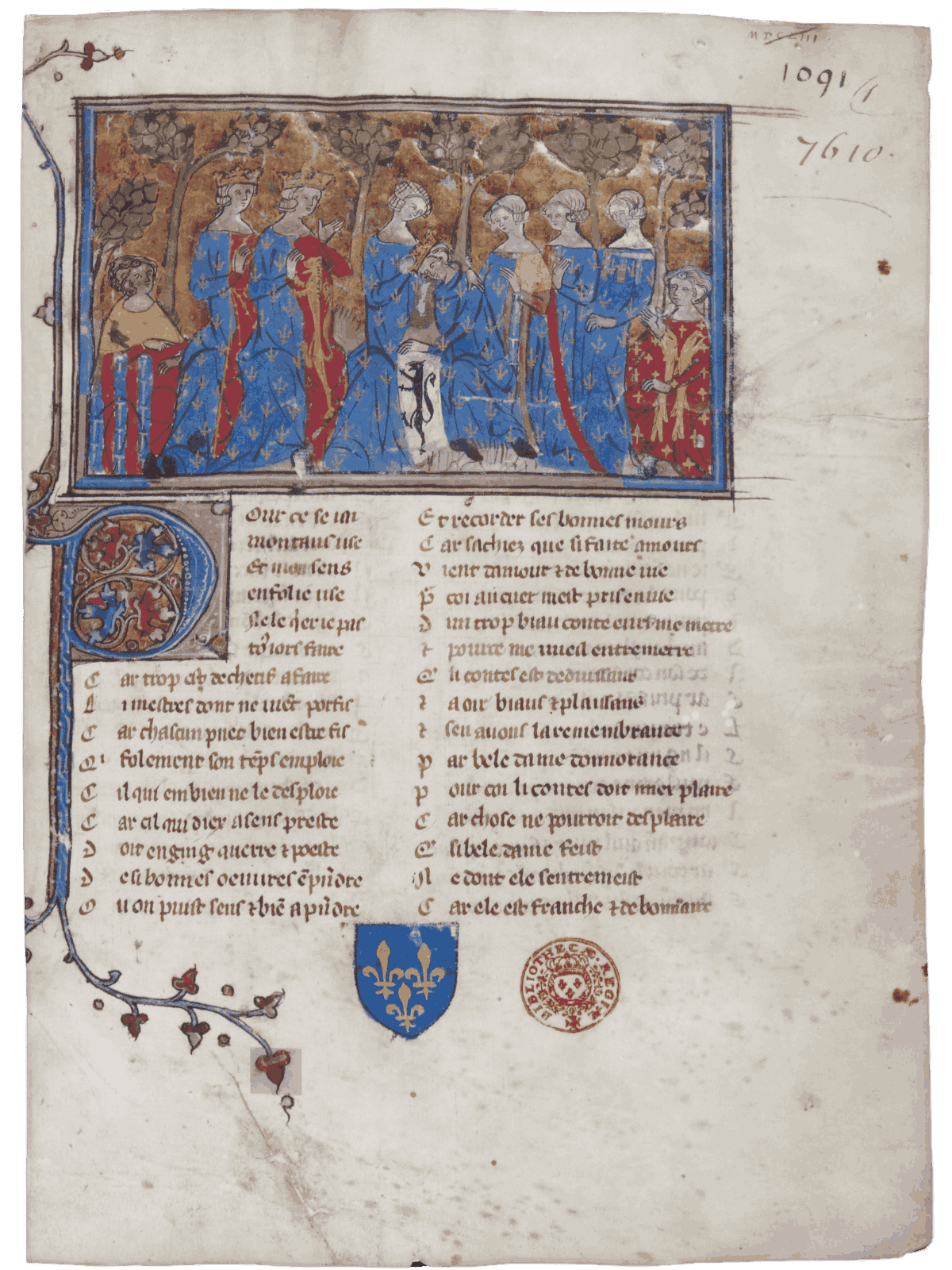
Bibliothèque nationale de France. Bibliothèque de l'Arsenal, Ms. 3142 - Facsimile of Editions Doce Calles
Adenet le Roi " Li roumans de Cleomades " in " Recueil d'anciennes poésies françaises ", folio 1r
A royal commission to a poet from Brabant has left us with a testimony of cultural transfer between the courts of Alfonso X and that of Philip III. In the initial illumination of this romance by Cleomades, Blanche de France appears clothed in the emblems of Castilla y León and represented with a gesture that indicates that she is speaking, telling her sister-in-law, the Queen Mary of Brabant, the tale of the Ebony horse, which he would have heard from a troubadour at the court of the Alphonsines in Seville or Toledo, the first introduction in France of one of the tales that would become part of the Tales of the Thousand and One Nights. The crown The carvings on it date it to around 1284.
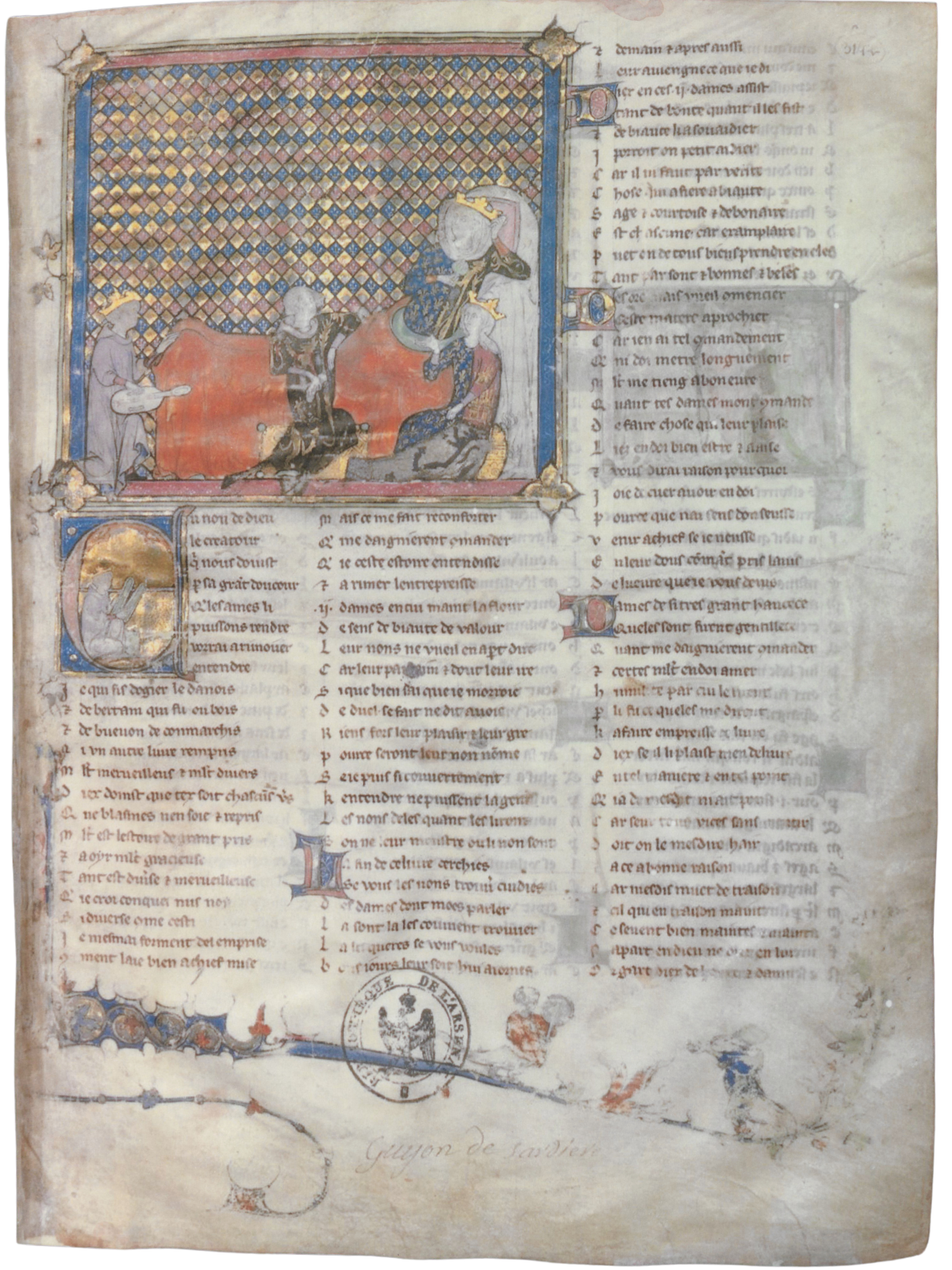
Bibliothèque nationale de France, mss Français 1589 - Facsimile of Ediciones Doce Calles
Girard d'Amiens, Meliacin ou le cheval de fust, f. 1
The illustrators of this romance entitled Méliacin ou le cheval de fust also dedicated the preliminary illumination to the commissioners of the work, Mary of Brabant y Blanche de France, and its author, Girard d'Amiens, identifies the latter as the source of the story, making it the bridge of a cultural transfer between East and West from which the court of Alfonso was to be an obligatory step. On this occasion, Blanca is depicted without a crown, consoling her nephew, along with other relatives. Philip IV whose father had just died in Perpignan, which makes it possible to date it to shortly after 1285.
Related content
War between Castile and Aragon
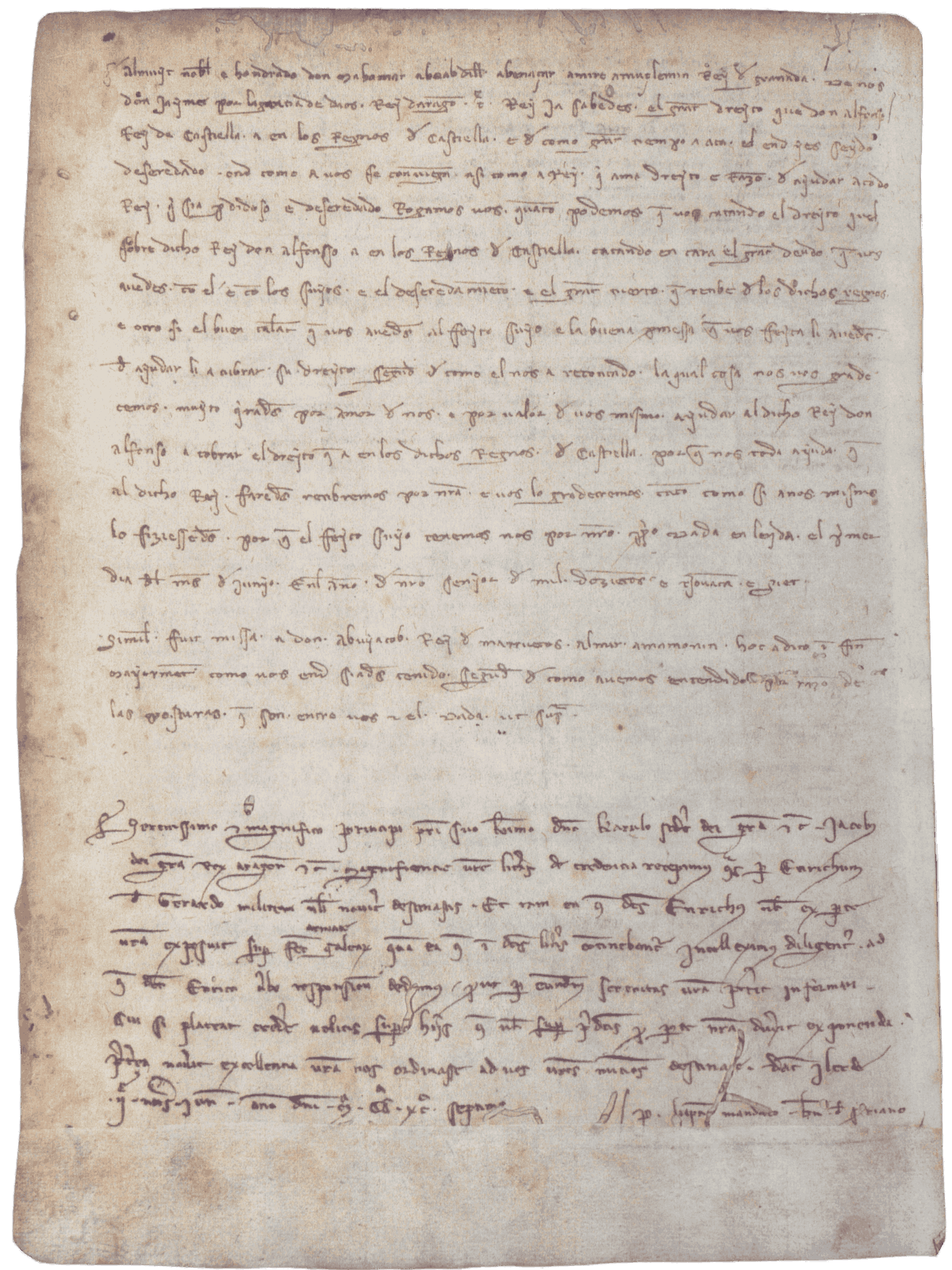
1297, June, 1. Lérida
Minute of the letter from James II to the King of Granada in which he reminds him of the "grant dreyto que don Alfonso Rey de Castiella a en los Regnos de Castiella" and asks him "como a rey qui ama dreyto, é razón de ayudar a todo rey, qui sia perdidoso, é desheredado" to help him - Archivo de la Corona de Aragón, cancillería reg. 252 fol. 62 vº / Facsimile
The response of the King of Aragon, Alfonso III the Liberal, to the peace that Sancho IV had signed with France was to release the Infantes de la Cerda and take them to Jaca, where, in the presence of Gastón de Bearne, Diego López de Haro and other Castilian nobles, proclaimed the first-born, Alfonso, king of Castile. This act led to open warfare between Castile and Aragon. The death of Sancho IV, leaving as his successor a child from his marriage with María de Molina who the church considered bigamous and incestuous, also fanned the flames of civil war, which was mitigated by Boniface VIII's legitimisation of Ferdinand IV on 6 September 1301.
Related content
Support from the House of Lara to the infants of La Cerda
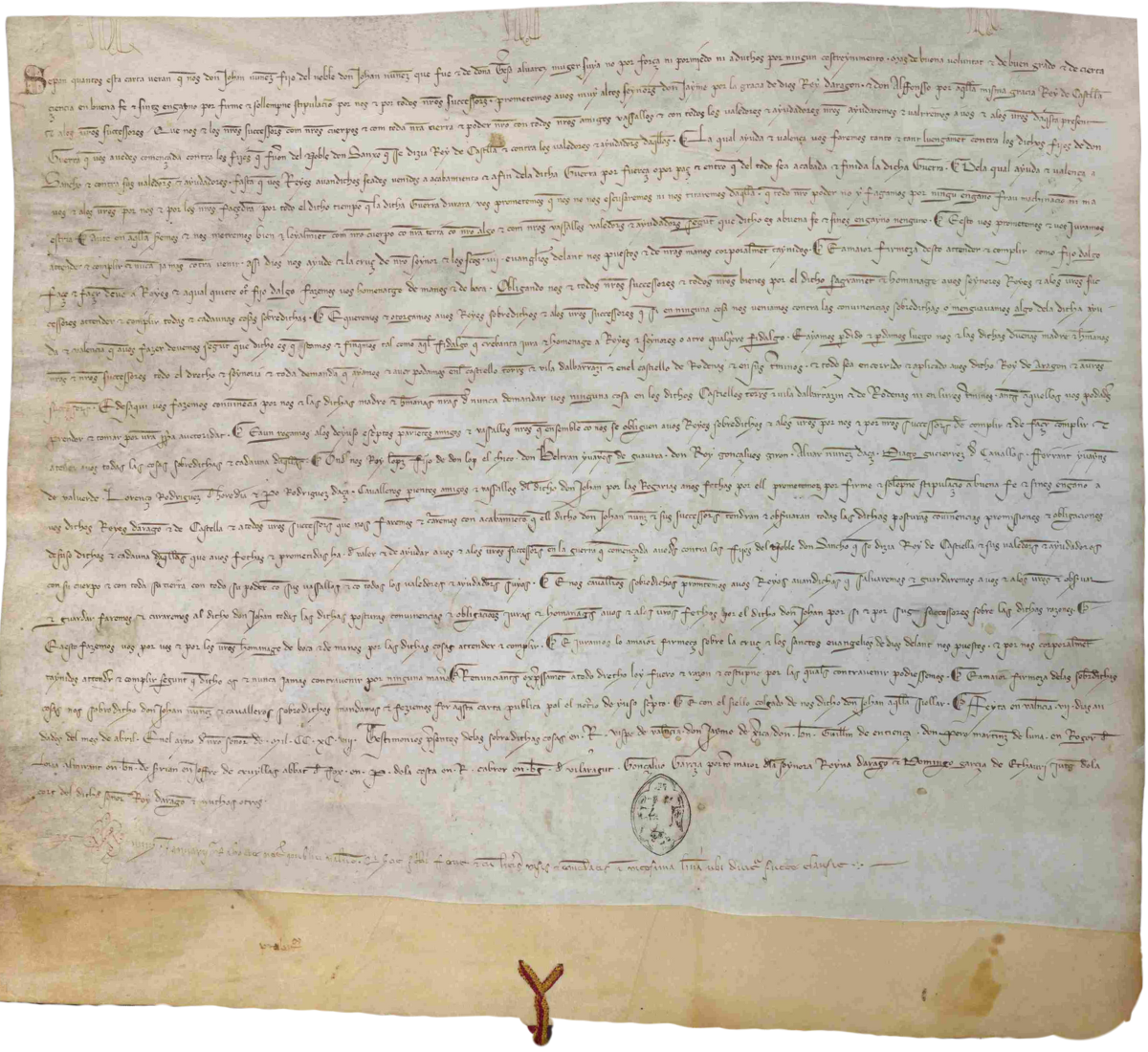
1298, April, 7. Valencia
Ducal Archives of Medinaceli, Historical Archives 185-2
Juan Nuñez de Lara (II), before the magnates of the kingdom of Aragon, makes "homenatge de manos e de boca" and swears an oath to help the kings of Aragon, James II, and of Castile, Alfonso [de la Cerda], against the sons of the "noble Don Sanxo who called himself King of Castile".
The father of this Juan Núñez de Lara, of the same name, was the person to whom he Fernando de la Cerda, on his deathbed, he entrusted the defence of the inheritance rights of his sons, which is why, on the death of Alfonso X, he placed himself at the service of Philip III of France. Fighting against Sancho IV, he lost the lordship of Albarracín in 1284 and, from then on, the recovery of this strategic state, halfway between Aragon and Castile, was to be the axis that marked the fickle alliances of this lineage with one king or another. His sister, Juana Núñez de Lara, known as the Palomilla, married Don Fernando de la Cerda.
Related content
Alfonso de la Cerda donates the town of Ágreda and its land to the King of Aragon
![don-alfonso-de-la-cerda-rey-de-castilla-dona-al-rey-de-aragon-la-villa-de-agreda-y-su-tierra-3-may-1298-archivo-ducal-de-medinaceli Don Alfonso [de la Cerda], King of Castile, donates the town of Ágreda and its land to the King of Aragon. 1298, May, 3. Serón. Ducal Archives of Medinaceli, Medinaceli 65-1.](https://fundacionmedinaceli.org/wp-content/uploads/2024/05/don-alfonso-de-la-cerda-rey-de-castilla-dona-al-rey-de-aragon-la-villa-de-agreda-y-su-tierra-3-mayo-1298-archivo-ducal-de-medinaceli.png)
1298, May, 3. Serón
Ducal Archives of Medinaceli, Medinaceli 65-1
Don Alfonso [de la Cerda], King of Castile, donates the town of Agreda and its land to the King of Aragon.
Even before the death of Alfonso X, the kings of Portugal and Aragon, took advantage of the conflict of succession to obtain territorial advantages at the expense of Castile. The liberation of the Infantes de la Cerda was linked to the peace with France for which Sancho IV accepted the creation for them of an independent kingdom of Murcia and Ciudad Real, an agreement that damaged Aragon's interest in extending into the former to reinforce its Mediterranean expansion. In this document, Alfonso, calling himself King of Castile, donates to James II the town of Agreda and its land, which included several castles bordering the kingdom of Aragon.
Related content
Torrellas arbitration award

1304, August, 8. Torrellas [1311, August. Pamplona. Transfer].
Ducal Archives of Medinaceli, Historical Archives 185-13
Sentence given by the Kings of Aragon and Portugal as arbitrating judges between Don Fernando King of Castile and Son Alfonso [de la Cerda].
The pontifical legitimisation of the birth of Ferdinand IV in 1301 and the disinterest of the King of France, The two arbitrators appointed by the parties to settle the question of succession, with Alfonso de la Cerda appointing the King of Aragon and Ferdinand IV the King of Portugal, greatly weakened the cause of Alfonso de la Cerda, forcing him to accept that two arbitrators appointed by the parties would settle the succession question. Both issued an award known as Torrellas arbitration award which obliged Alfonso de la Cerda to stop using the voice of king and his "right" arms, and in return he would receive a large group of lordships scattered throughout the country. Castile, Leon and Andalusia. In the same sentence, it was agreed that the kingdom of Murcia would be divided between Castile and Aragon setting the border at the Segura River.
Related content
The weakening of royal authority
Mero e misto imperio
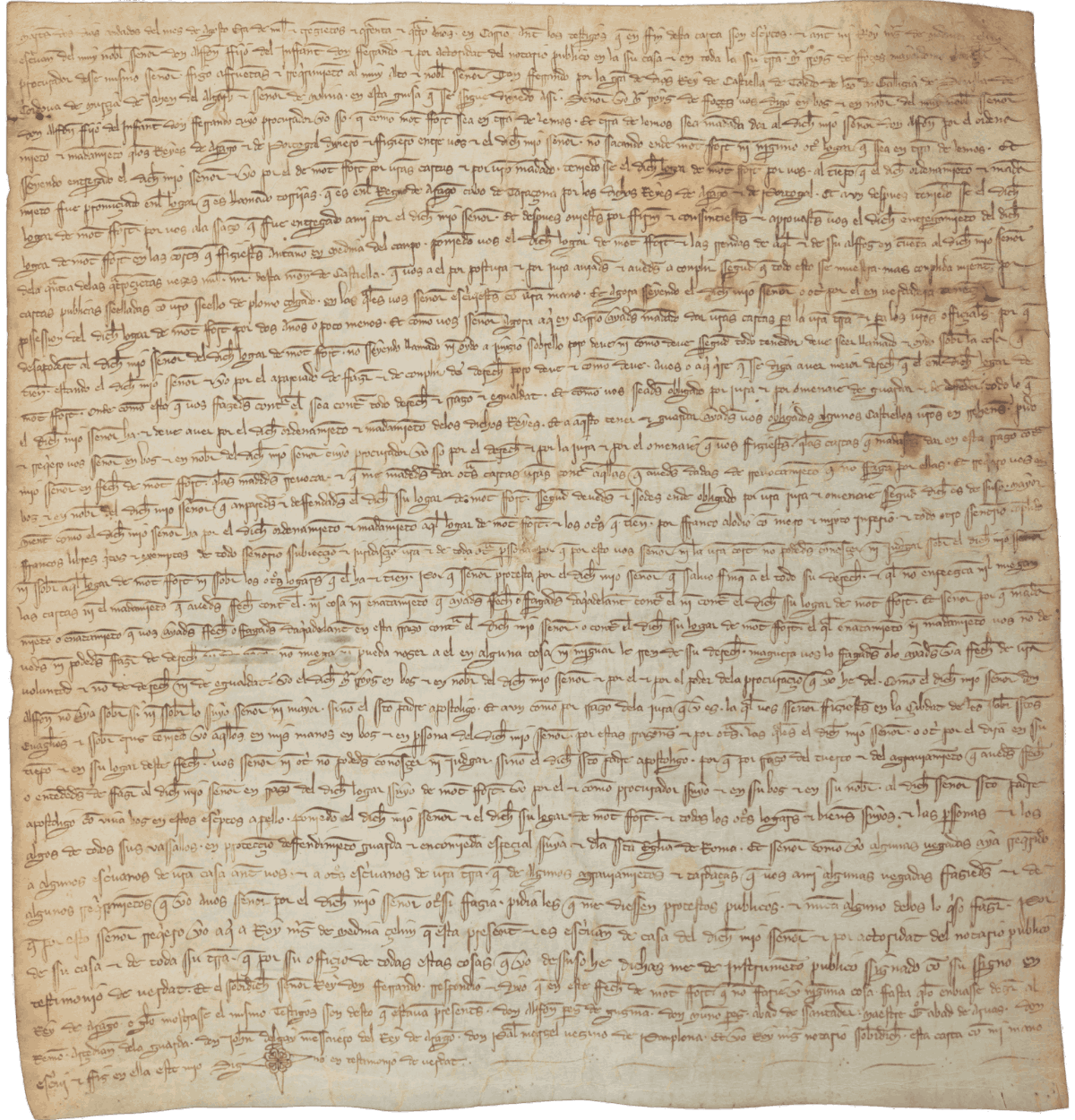
1306, August, 2. Carrión
Ducal Archives of Medinaceli, Historical Archives 185-22
Martín Ruiz de Hoces requests Fernando IV that his officers do not send letters against Monforte or the other villas and vassals of Don Alfonso.
The lordships of the sentence were granted "with all jurisdiction mero e misto imperio exentos e quitos de [...] servitude and sennorio also of appeal [...] of the said king don Fernando". This is the first time in Castile this concessionary formula is used, the "mero e misto imperio', that by granting full jurisdiction, it created an autonomous demarcation of the State. This is what the Steward of Alfonso de la Cerda to the king Ferdinand IV "non podedes conoscer ni judgar sobre el dicho mio señor nin sobre aquel lugar de Monfort nin sobre los otros lugares".
Related content
The resistance of the councils
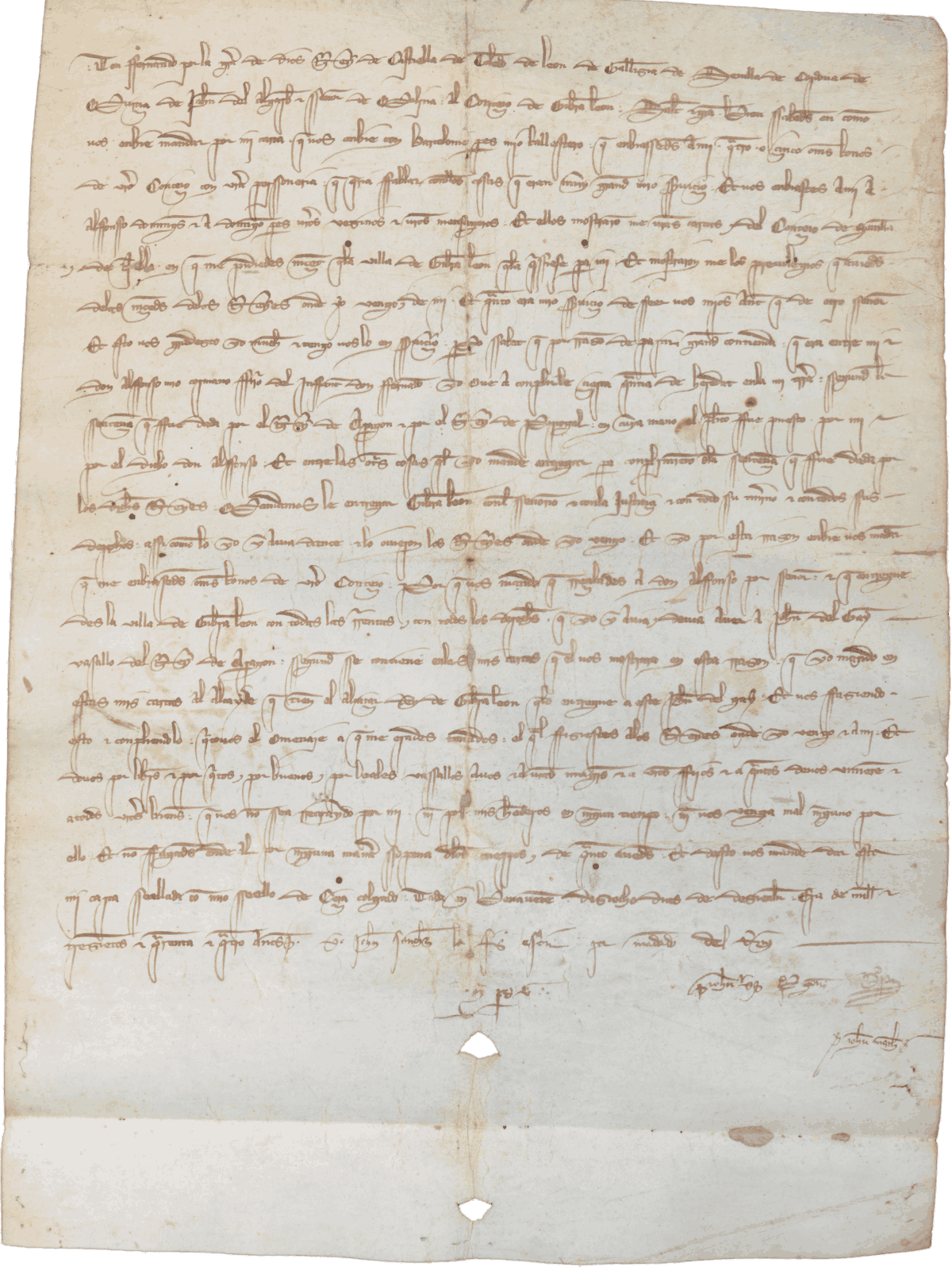
1306, December, 18. Benavente
Archivo Ducal de Medinaceli, Puerto de Santa María, 1-3
Fernando IV orders the council of Gibraleón to admit Alfonso de la Cerda as its natural lord.
This manor was on the list of those that the arbitrator kings granted to Alfonso de la Cerda at Torrellas and provided 20,000 ms per year of the "amount of inheritancet" of 400,000 that they set. However, Ferdinand IV took more than two years to formalise the concession, undoubtedly due to the council's reluctance to pass to the seigniorial jurisdiction, as shown by this mandate from the king in which he explains to the council that the privileges they had shown him of "the kings from whence I come and from me", and orders him to "you receive Don Alfonso for your lord" and to hand over the town and its fortress to the procurator of the King of Aragon.
Related content
Alfonso de la Cerda, "king" in his manor

1315, February, 20. Gibraleón
Ducal Archives of Medinaceli, Puerto de Santa María, 1-4
Letter of mercy by which Alfonso de la Cerda grants the council of Gibraleón franchises and exemptions and confirms those already in existence.
With the intention of attracting settlers, Alfonso de la Cerda, by this letter of mercy, renounced some of the manorial monopolies and granted a broad set of franchises to the council and the neighbours to Gibraleón, order described by the teacher Ladero Quesada as "one of the earliest and undoubtedly most open examples of compromise between the manorial power and the municipal and neighbourhood powers that we can find in the Andalusia in the 14th century. It is clear that Alfonso de la Cerda's quasi-royal status allowed him to offer concessions with an unusual freedom for the time.".
Related content
First stately concession of a fair
![don-juan-alfonso-de-la-cerda-concede-an-annual-fair-a-gibraleon-9-july-1323-santarem-archivo-ducal-de-medinaceli-archivo-historico-276-4 Don Juan [Alfonso] de la Cerda grants an annual fair to Gibraleón. 1323, July 9. Santarem. Ducal Archive of Medinaceli, Historical Archive 276-4.](https://fundacionmedinaceli.org/wp-content/uploads/2024/05/don-juan-alfonso-de-la-cerda-concede-una-feria-anual-a-gibraleon-9-julio-1323-santarem-archivo-ducal-de-medinaceli-archivo-historico-276-4.png)
1323, July, 9. Santarem
Archivo Ducal de Medinaceli, Archivo Histórico 276-4
Don Juan [Alfonso] de la Cerda grants an annual fair to Gibraleón
It seems that, in 1320, Alfonso de la Cerda ceded the town of Gibraleón to his son Juan Alfonso, whose life was spent mainly in Portugal, where he married a daughter of the King Don Dionís. Like his father, he was a munificent and absent lord, as is shown by this letter of mercy, given in the Portuguese city of Santarem, by which he granted Gibraleón an annual fair, of which the Professor Ladero Quesada comments that it is "the first news we have of a fair born by seigniorial decision in Andalusia, with all the characteristics of tax breaks and safety and insurance for the participants and their goods inherent to this type of concessions when they are promoted by the Kings".
Related content
The disinherited lineage and the creation of the County of Medinaceli
Alfonso de la Cerda renounces the voice of king
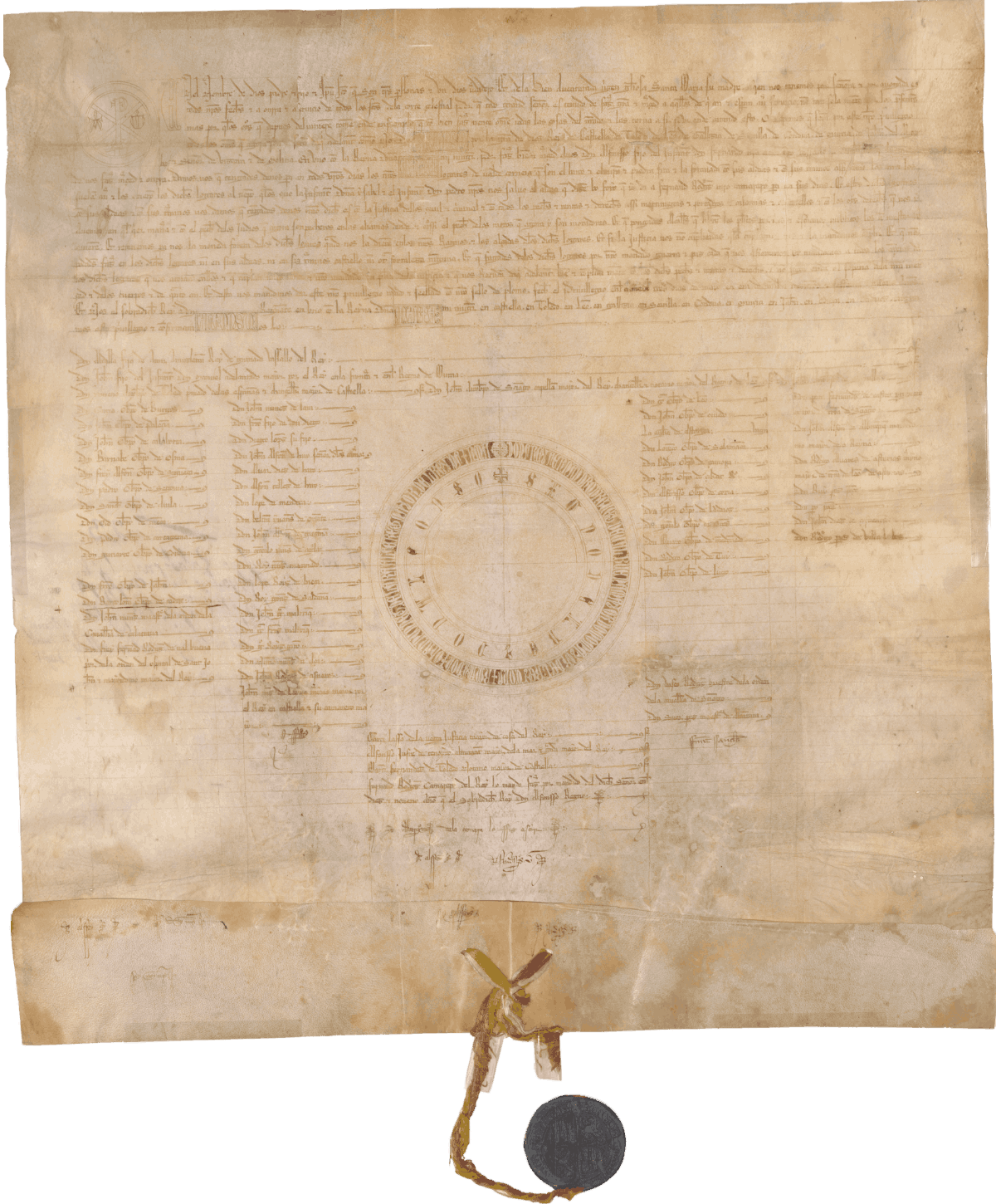
1331, May, 3. Almendralejo
Archivo Ducal de Medinaceli, Privilegios rodados, nº 28
Privilege of Alfonso XI granting the places of Valdecorneja, El Barco, El Mirón, Piedrahita and La Horcajada to Alfonso de la Cerda.
Alfonso de la Cerda, by losing part of their states in one of the many intrigues of the minority of Alfonso XI, took refuge in France until, in 1331, according to the chronicle, he went to meet the king and "renounced and gave up any voice or right he had in the kingdoms of Castiella and León; [...] and granted himself as their vassal". This privilege includes, in similar words, the tribute he paid to the king, by which it regained some of the states it had possessed and won others, but without full jurisdiction, a sign of the recovery of royal authority under Alfonso XI.
Related content
Testament of Alfonso de la Cerda

1334, December, 23. Piedrahita
Ducal Archives of Medinaceli, Historical Archives 185-31
Power of attorney granted by Alfonso de la Cerda to his wife, Mafalda, his son Juan, his son-in-law and his confessor.
Alfonso de la Cerda must have died shortly after grant this power of testamentary authority. There is no consensus on the identity of his wife Mafalda, although the most likely hypothesis is that she was a daughter of the Count of Eu. She had six children who lived between France and Spain. Although all his daughters married in Castile, one of them, Margarita, to the infante Felipe, son of Sancho IV, none of them had an heir who survived him. His sons did not fare much better either, except for the first-born, Luis, who, from his marriage to Leonor de Guzmán, had a long line of descendants.
Related content
The first-born "Louis d'Espagne" in the service of the King of France
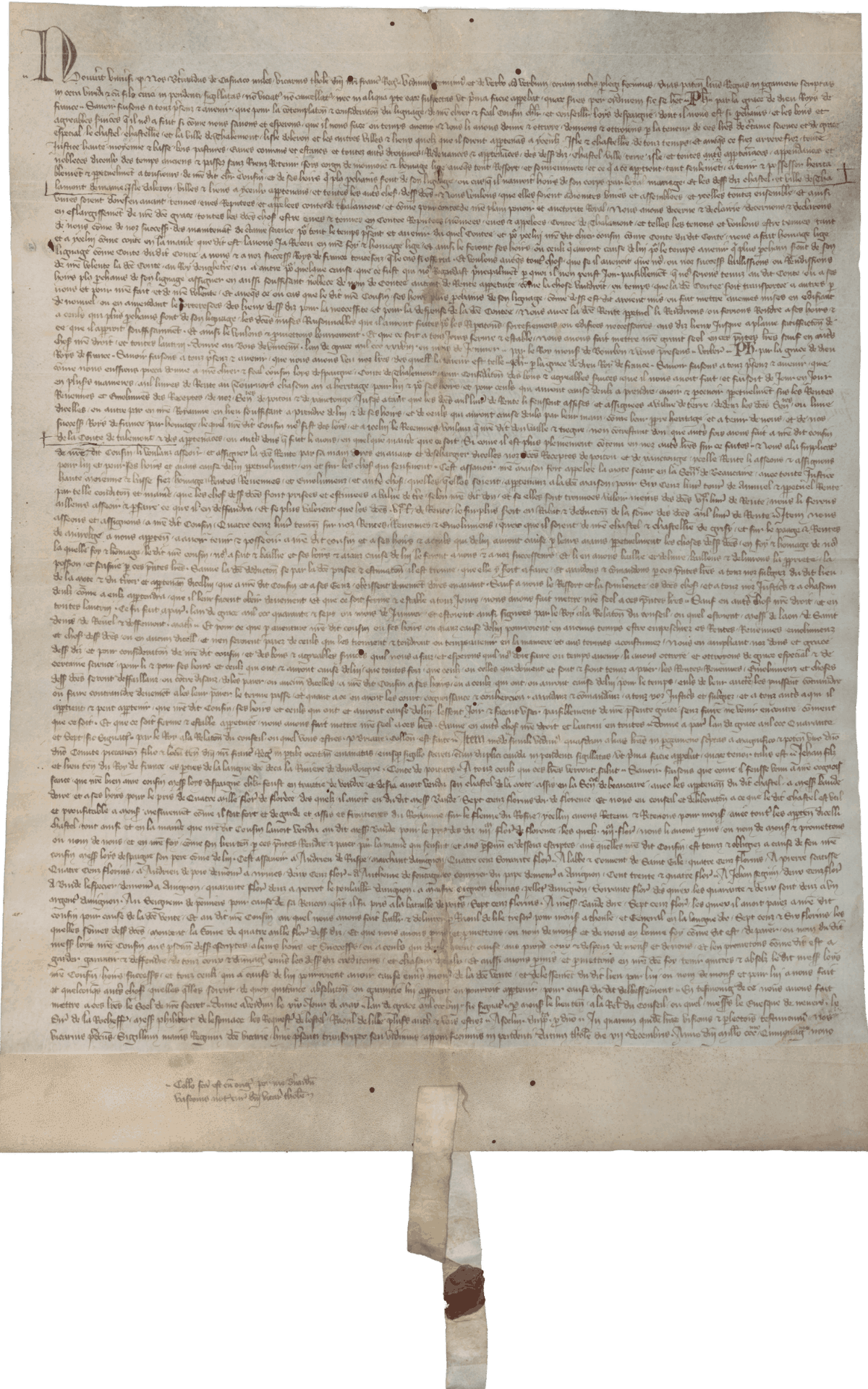
1339, January. Forest of Vincennes
Ducal Archives of Medinaceli, Historical Archives 185-36
Transfer of the privilege by which Philip VI of France grants Louis of Spain the County of Talmont.
The first-born son of Alfonso de la Cerda who received some lordships in Cáceres from his father, lived between Spain and France. In 1306 he married in Seville Leonor de Guzmán, a daughter of Guzmán el Bueno, for whom he was lord of Puerto de Santa María, and in 1332, the chronicle of Alfonso XI places him at his father's side at the coronation ceremony of Alfonso XI. However, his public life was spent in France. in the service of Philip VI of Valois where he was known as Luis de España. As a reward for his services, the king granted him the county of Talmont on the border of the English possessions in the south of France.
Related content
Henry II creates the County of Medinaceli and offers it to Isabella de la Cerda
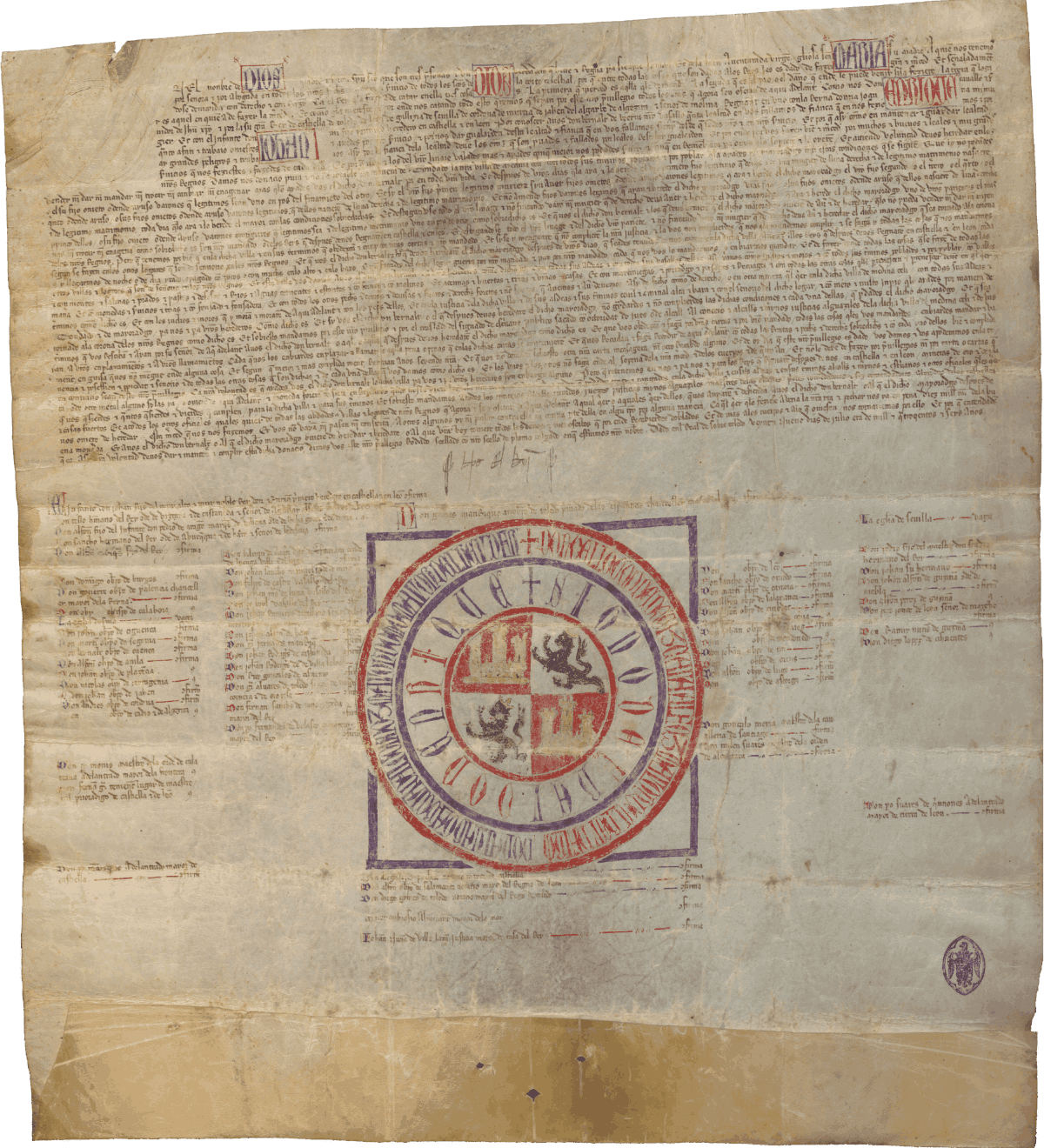
1368, July, 29. Royal over Toledo
Archivo Ducal de Medinaceli, Privilegios rodados, nº 43
Privilegio rodado of Henry II granting Don Bernardo de Bearne the town and land of Medinaceli with the title of county.
Bernard of Bearne, a son of the Count de Foix, entered Castile to fight alongside Henry of Trastámara in the civil war that pitted him against his brother, King Pedro. Nine months before the fratricide of Montiel, Henry II, in gratitude, granted him, with the dignity of a county and the mere mixed empire, the town of Medinaceli with the one hundred and seven villages that made up its alfoz. Thus, a new dynastic conflict broke the work of Alfonso XI, as he took a territory out of the realengo with a formula that removed it from the royal authority.
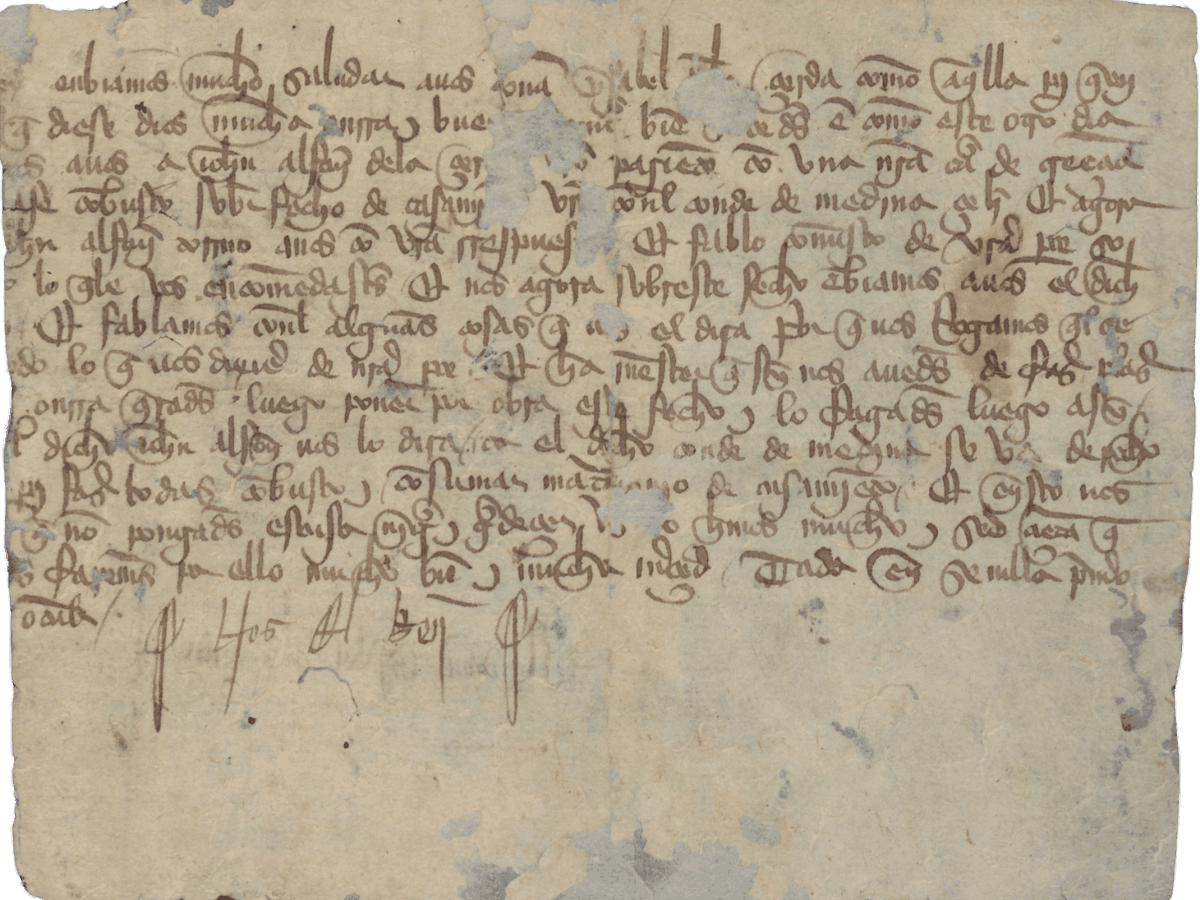
1370, October, 1. Seville
Ducal Archives of Medinaceli, Medinaceli 9-33
Letter from King Henry II to Doña Isabel de la Cerda begging her to marry the Count of Medinaceli
Since the execution of his brother Juan in 1357 by King Pedro, Isabel de la Cerda y Guzmán was the last descendant of the disinherited infant, Alfonso de la Cerda. It is possible that for this reason, because Isabella represents the first-born line of Alfonso X, the first Trastámara was so interested in Isabella marrying his loyal vassal. Bernard of Bearne. Henry II had no other compensation for his bastardy than the royal blood of his wife Doña Juana Manuel, the granddaughter of the second of the infantes de la Cerda. Thus, in this letter, he tells her that, if she gets married "sed çierta que uos faremos [,,,,] mucho bien e mucha merçed".
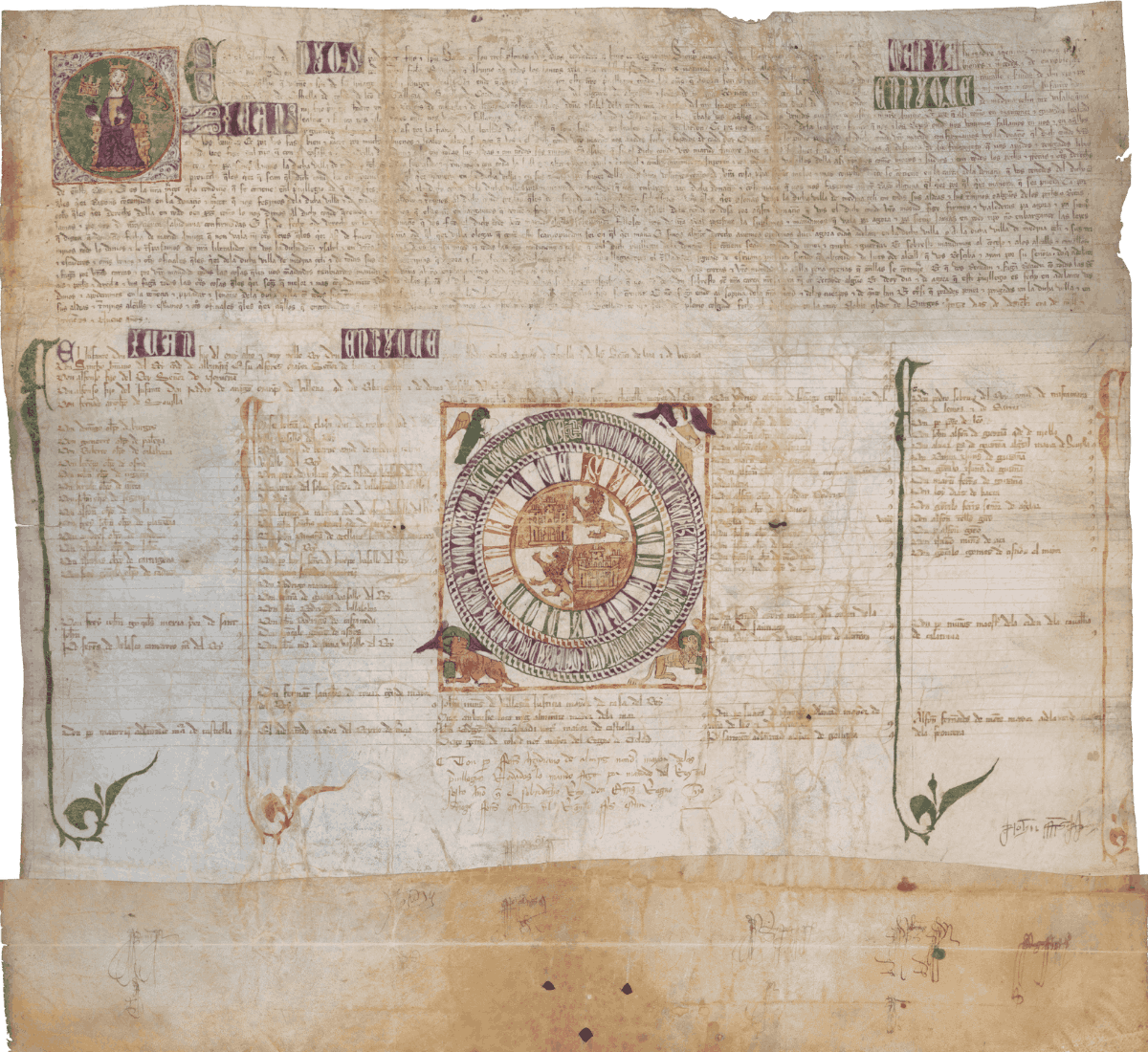
1371, December, 15. Burgos
Archivo Ducal de Medinaceli, Privilegios rodados, nº 56
Privilegio rodado of Enrique II confirming to Doña Isabel de la Cerda the donation made to her by her husband, Bernal de Bearne, of the County of Medinaceli.
Before her marriage to Bernard of Bearne, Isabel de la Cerda, was already mistress of Puerto de Santa María and of several other lordships located in Cáceres, Seville and León. The wedding with Bernardo de Bearne must have taken place a few days after the Henry II's plea, for in October 1370, in the presence of notaries from Garganta la Olla, In 1379, Bernardo de Bearne confirmed the donation to his wife of the county of Medinaceli and eight hundred thousand maravedis as a deposit, a donation that Henry II confirmed by this privilege. In 1379, as soon as he acceded to the throne, John I restored him to his brother's estate. Juan: Gibraleón and Huelva.
Related content
A dual memory
Juan I legitimises himself as the successor to the Infantes de la Cerda
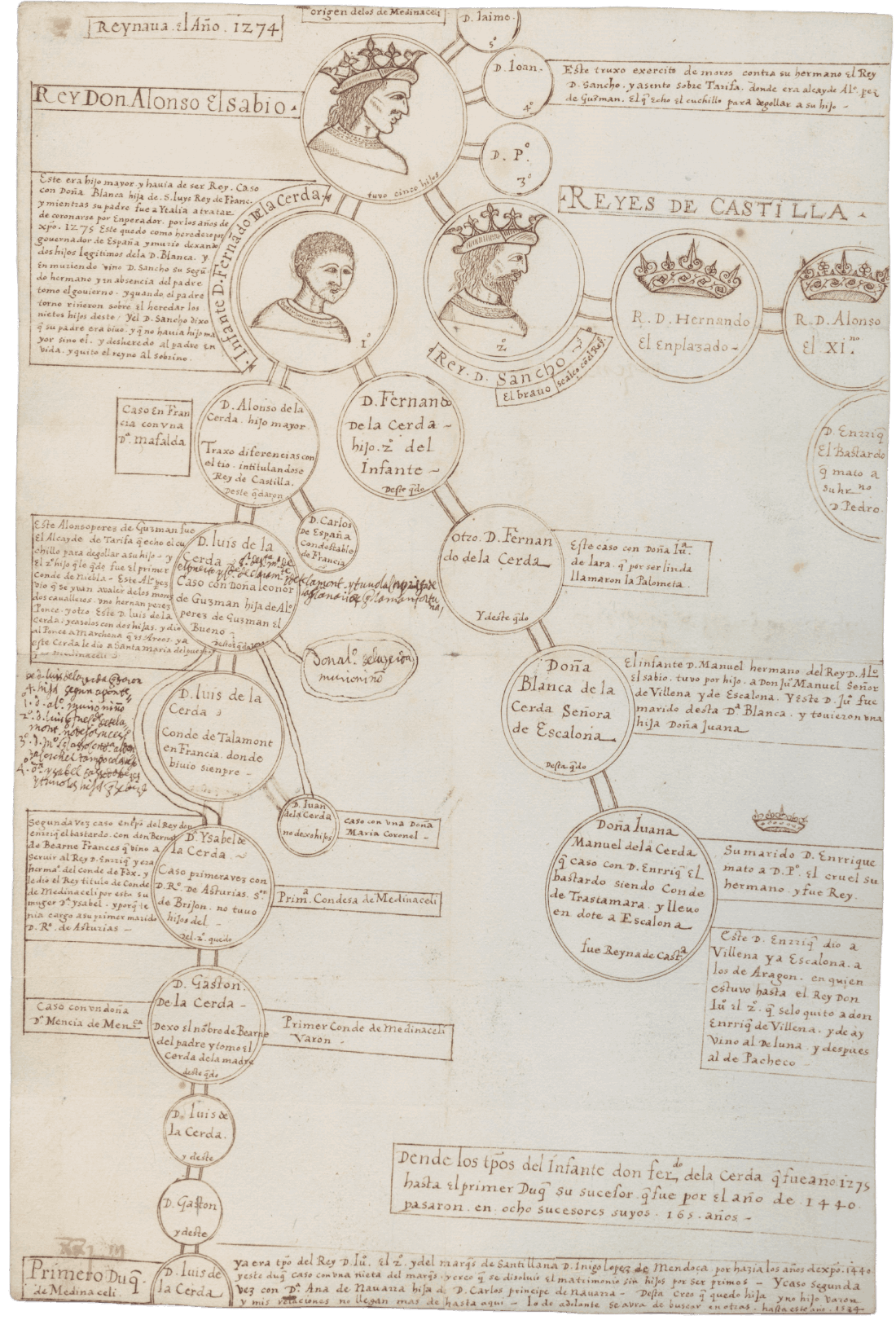
1584
Marquis of Mondéjar. Memorias históricas del Rei don Alonso el sabio i observaciones a su chrónica. Madrid 1777, p 526 - Archivo Ducal de Medinaceli, Medinaceli-CAJA-II
Family tree from Alfonso X to Luis de la Cerda, I Duke of Medinaceli, with portraits of Alfonso X, the Infante Fernando de la Cerda and King Sancho IV.
In November 1386, after the disaster of Aljubarrota, under pressure from the troops of the Duke of Lancaster that, as the husband of Constanza de Castilla, daughter of King Don Pedro, claimed the throne of Castile, King Juan I, before the Cortes convened in Segovia, based its legitimacy in this way:
"[...] and first of all we descend legitimately from the line of the said King Don Alonso and of his fixed son the Infante D. Fernando, e de sus fijos que fueron desheredados por el Infante don Sancho We are also legitimately descended through the right line of the Infante D. Manuel, who was fixed to the King Don Fernando who won Seville: and likewise, as we are descended through the other line of the King Don Sancho, and of Don Fernando, and of D. Alonso, our grandfathers: and furthermore, by el rei D. Enrique nuestro padre, que Dios perdone, el cual hovo mui grandes derechos en este reino por algunas razones, señaladamente por ser casado con la reina nuestra madre".
Related content
The House of Medinaceli cultivates the memory of its royal ancestry

Circa 1485
Ducal Archives of Medinaceli, Medinaceli, 3-1
Genealogical tree of the Medinaceli house from the first King of Castile to the first Duke of Medinaceli.
Commissioned by the 1st Duke of Medinaceli to the "General Survey teachers" of Salamanca, according to the cartouche at the foot of the parchment, the allusion made in the long dedication to the Catholic Monarchs, to the gentlemen who "with your highness are in the conquest of the Kingdom of Granada"sets the year 1492 as the ante quem of its elaboration.. The presence of the first Duke of Medinaceli in the war of Granada is documented in various years of the 1480s. On the other hand, the description of his daughter Leonor, "that the King of Navarre is entitled to, as examined by the doctors of this study."This is an indication of the possible purpose of the entrustment to the Salamancan scholars and further clarifies its dating, for in 1483 he died Francis I of Foix and the catholic kings refused to recognise as Queen of Navarre his sister Catalina.
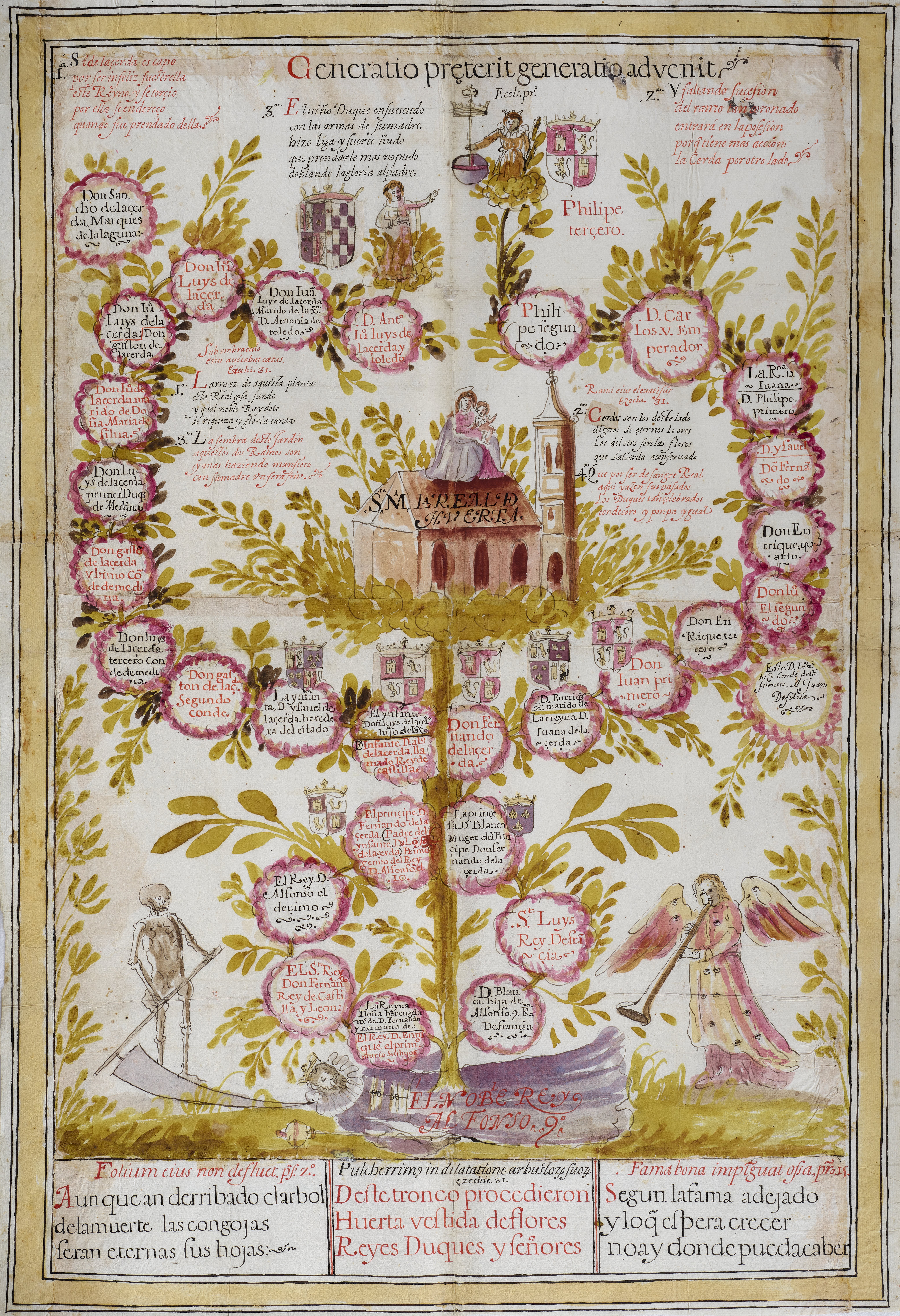
Circa 1615
Ducal Archives of Medinaceli, Medinaceli, 2-20.
Generatio preterit, generatio advenit. Genealogical tree of the House of Medinaceli from Alfonso VIII (9th) to the VII Duke of Medinaceli.
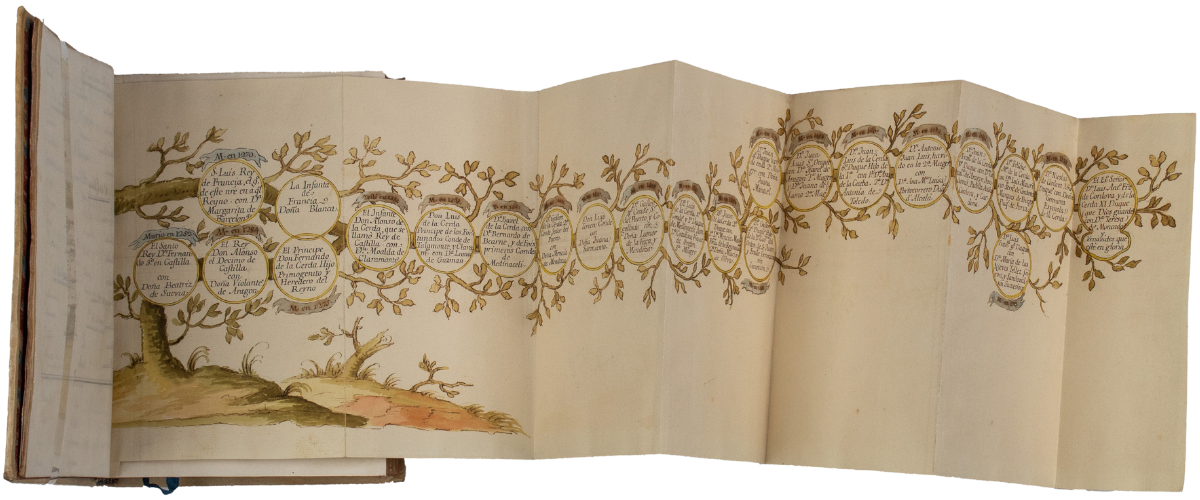
Madrid Year 1757
Ynventario general de todos los papeles de este archivo pertenecientes al estado de Medinaceli, propio del Excmo. duque don Luis Antonio Fernández de Córdoba, Espinola y de la Cerda, mi Señor.
In the 18th century, the archive of the house of Medinaceli was centralised in Madrid, receiving in his palace on the Paseo del Prado the collections of the different houses attached to that of Medinaceli. The archivists reordered and catalogued the funds of each of the houses they received, generating two types of inventory, a thick working copy and a smaller one, with beautiful heraldic binding in parchment with the arms of the house they catalogue, marbled endpapers and, as an opening, a family tree fold-out and coloured in watercolour.

